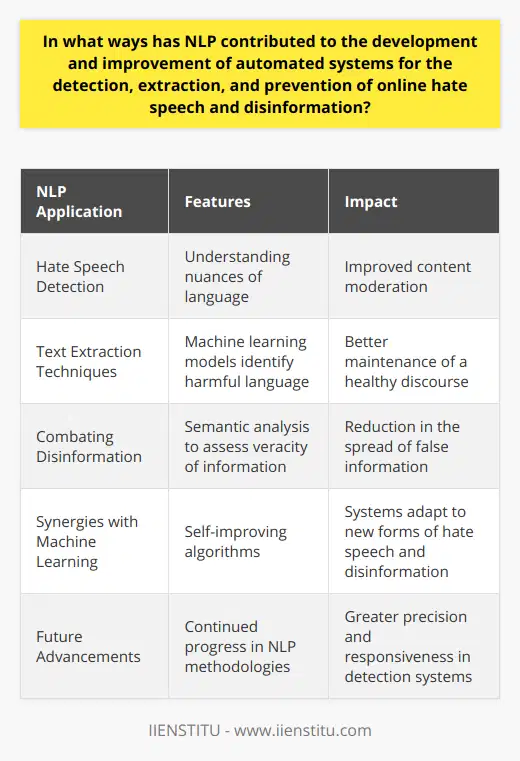
In this blog post, we'll be discussing some of the most common problems that can be solved with Neuro-Linguistic Programming techniques. We'll provide a brief overview of each issue and how NLP can be used to address them. Remember that NLP is not a silver bullet, and it may not work for every situation – but it's worth exploring if you're struggling with any of these issues. So without further ado, let's get started!
How to solve common problems with NLP?
1. Lack of confidence
One of the most common problems people face is a lack of confidence. This can manifest in many different ways, from being afraid to speak up in public to struggling to ask for a raise at work. NLP can be an excellent tool for helping you to overcome these fears and build your confidence. One of the essential techniques is to reframe your thinking. For example, if you're afraid of public speaking, you can tell yourself that it's an opportunity to share your ideas with others and positively impact. This simple change in perspective can help you approach the situation with more confidence.
Most people have experienced some form of stage fright or anxiety at one point or another. Nerves can quickly get us, whether it's giving a presentation at work, going on a first date, or taking an important exam. But what if there was a way to conquer those nerves and boost your confidence? Neuro-linguistic programming (NLP) is one technique that can help increase self-confidence and reduce anxiety. By changing the way we think about and talk to ourselves, NLP can help to rewire our brains and create new, positive beliefs. For example, instead of saying, "I'm so nervous," you can tell yourself, "I'm excited and ready for this." Small changes like this can make a big difference in how you feel and perform in high-stress situations. So next time you're feeling nervous about an upcoming event, try using some NLP techniques to help boost your confidence.
2. Procrastination
Another common issue that people face is procrastination. This can be a real problem if it's stopping you from achieving your goals or reaching your full potential. NLP can help you overcome procrastination by teaching you how to set practical goals and break them down into smaller, more manageable steps. Additionally, NLP can help you develop better time management and organization skills, making it easier to stay on track and avoid procrastination.
Related Course: Time Management Training Course
How to overcome procrastination using NLP techniques?
One way to overcome procrastination is to change your mindset. Instead of thinking of your goal as a giant, daunting task, try to break it down into smaller, more manageable steps. This will make it feel less intimidating and more doable. Additionally, it's essential to get rid of any negative self-talk holding you back. For example, if you tell yourself that you're not good enough or that you'll never be able to achieve your goal, you're only setting yourself up for failure. Instead, focus on positive self-talk and visualizations. For example, picturing yourself achieving your goal can help to increase your motivation and confidence.
Finally, it's essential to take action. No matter how small the step, it's necessary to get started. Once you've taken that first step, the rest will become more accessible and manageable. By using these simple NLP techniques, you can overcome procrastination and
3. Negative thoughts and self-talk
Many people struggle with negative thoughts and self-talk, leading to a downward spiral of low self-esteem and confidence. NLP can help you identify these negative thoughts and reframe them in a more positive light. For example, if you're constantly telling yourself that you're not good enough, you can reframe this thought to something like, "I'm doing my best, and I'm learning from my mistakes." This simple change can make a big difference in how you feel about yourself and your ability to achieve your goals.
How to identify and challenge our negative thoughts?
We all have a little voice in our head that can be our worst critic. This voice might say things like "you're not good enough" or "you'll never be successful." This negative self-talk can be destructive and lead to feelings of anxiety, depression, and low self-esteem. It can also prevent us from taking risks and trying new things. Therefore, if we want to live our best lives, it is essential to learn how to identify and challenge these negative thoughts.
The Hidden Gems Source Of Wisdom Ancient Philosophies Personal Experiences Nature Lessons
Comprehensive Approach To Breaking Depression Combining Acceptance With Action
One way to identify negative thoughts is to pay attention to your emotions. For example, if you notice that you are feeling down or anxious, it may signify that you are thinking negative thoughts. You can also look for any patterns in your thinking. For example, do you always assume the worst when something goes wrong? Once you have identified your negative thoughts, you can start to challenge them. For instance, ask yourself if there is evidence to support the idea. For example, is it true that you're not good enough? Or is this just something that you're telling yourself? It can also be helpful to imagine what you would say to a friend who was having these same thoughts. Would you tell them that they're not worth anything? Or would you offer encouragement and support? By learning to identify and challenge our negative reviews, we can start to feel better about ourselves and conquer the world.
4. Relationship issues
Relationship issues are another common problem that people face. This can include anything from communication problems to difficulties trusting or being close to others. NLP can help you improve your communication skills, build trust, and develop more intimate relationships. One of the essential techniques is rapport building, which involves creating a connection with another person by mirroring their body language and vocal patterns. This helps to create a feeling of mutual understanding and trust, which can be very helpful in resolving relationship issues.
How can NLP help us to build healthier relationships?
When it comes to relationships, NLP can be used to improve communication, resolve conflicts, and build deeper rapport. For example, by understanding our communication style, we can learn to speak in a more feasible way to be heard and understood by our partners. We can also use NLP to understand better what our partner is saying, even when they are not using words. Finally, by becoming more aware of our thoughts and feelings and those of our partners, we can build healthier relationships based on mutual respect and understanding.
5. Difficulty making decisions
Many people have difficulty making decisions, whether choosing what to wear in the morning or deciding on a career change. NLP can help you overcome this by teaching you how to clarify your goals and values and make decisions based on what's important to you. Additionally, NLP can help you develop better problem-solving skills to approach decision-making more logically and effectively.
How to know if you're having difficulty making decisions?
Making decisions is a part of everyday life, but sometimes it can be challenging to know if you're having difficulty making decisions. A few key signs may indicate that you're struggling to make choices:
You may find yourself second-guessing your decisions or dwelling on what could have been.
You may have trouble considering all of the potential outcomes of a decision.
You may experience anxiety or indecision when faced with multiple choices.
If you're experiencing any of these symptoms, it's essential to seek help from a mental health professional. With their guidance, you can learn how to make decisions more effectively and reduce the stress of making choices.
6. Stress and anxiety
Stress and anxiety are widespread problems that can significantly impact your life. NLP can be used to help you to manage stress and anxiety more effectively. One of the essential techniques is called anchoring, which involves creating a positive association with a particular stimulus (such as a sound or smell) that can help to calm and focus you when you're feeling anxious. Additionally, NLP can help you develop better-coping strategies for dealing with stress and anxiety-provoking situations.
NLP is a powerful tool that can overcome a wide range of common problems. If you're struggling with any of the issues mentioned above, then NLP could be just what you need to help you get back on track and achieve your goals.
If you're experiencing any of these common issues, know that you're not alone. Millions of people around the world deal with similar problems daily. However, there is hope. By enrolling in our upcoming NLP course, you can start to address and overcome these challenges head-on. With the help of our experienced trainers and support community, you can finally take control of your life and reach your full potential. So what are you waiting for? Register today!
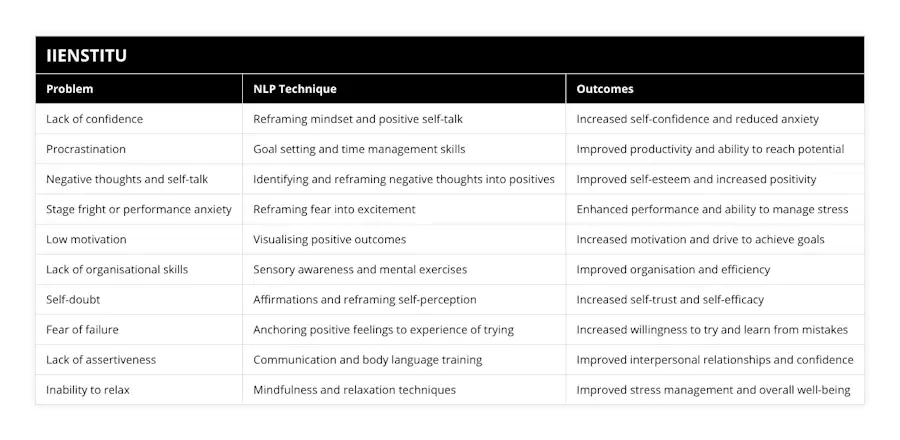
Frequently Asked Questions
How can NLP be used to help people with anxiety?
There are many ways that NLP (Natural Language Processing) can be used to help people with anxiety. For example, NLP can be used to process and understand the language of people with anxiety disorders to be better treated. It can also be used to develop therapeutic techniques and treatments specifically for people with anxiety. Additionally, NLP can be used to analyze social media posts and other online communications to understand better how stress manifests itself online and how best to support those suffering from it. Ultimately, NLP is a powerful tool that can be used in various ways to help people manage their anxiety more effectively.
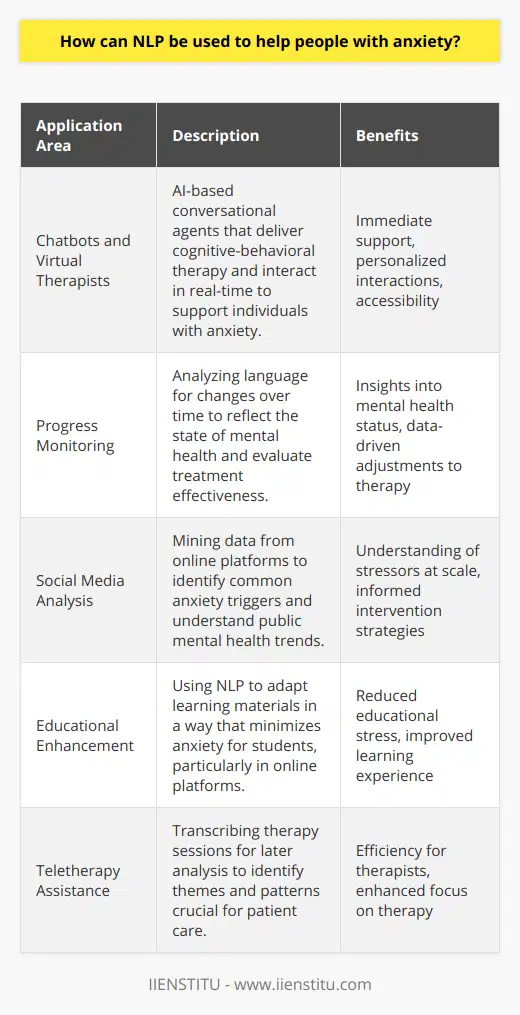
Can NLP be used to help people with eating disorders?
Yes, NLP (neuro-linguistic programming) can be extremely helpful for people with eating disorders. NLP is all about helping people to change their thinking and behaviours, and this can be very effective in treating conditions like anorexia and bulimia.
NLP can help people to understand their thoughts and feelings around food, and learn to respond to them in a more positive way. It can also help people to develop a healthy relationship with food, and reduce the negative associations they may have with certain foods.
If you or someone you know is struggling with an eating disorder, please seek professional help. NLP can be an extremely effective treatment for eating disorders, but it should not be attempted
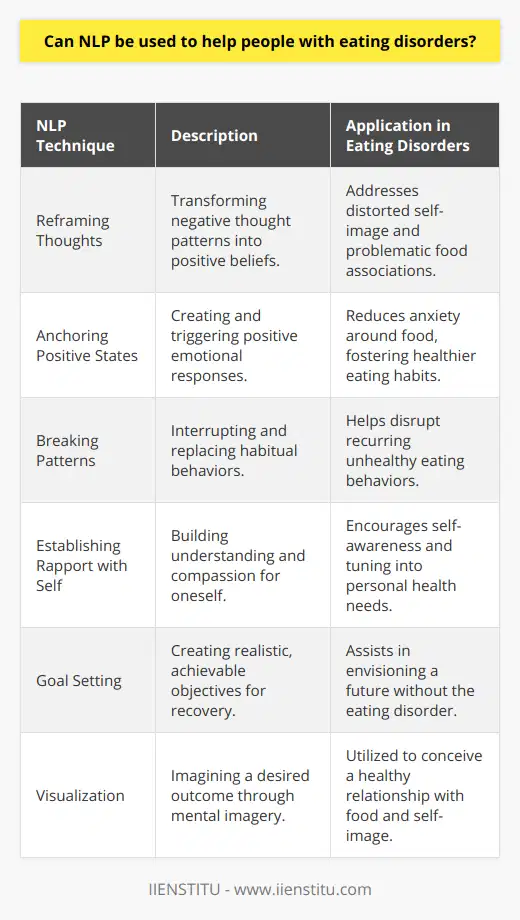
How can NLP be used to improve communication?
NLP can be used to improve communication by teaching people how to use their words and body language to create a clear message.
When you use NLP, you learn how to put yourself in the other person's shoes so that you can understand their perspective. You also learn how to use your voice and body language to send a clear message. This can be helpful in business and personal relationships alike.
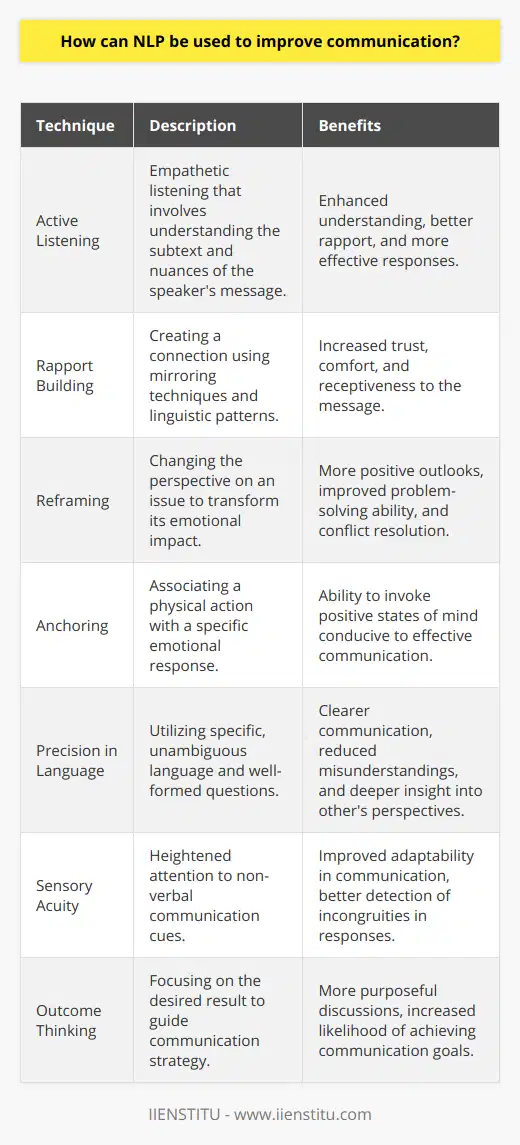
What does NLP solve?
Problem Solving through NLP
Natural Language Processing (NLP) solves various problems in different domains by facilitating the understanding, interpretation, and generation of human language by computer systems. It provides effective means to analyze and make sense of the vast amount of text and spoken data produced daily, enabling advancements in several disciplines.
Enhancing Human-Computer Interaction
NLP revolutionizes human-computer interaction by allowing computers to efficiently interpret and respond to human-generated input. Through NLP, computers provide instant feedback and solutions to users' queries, enhancing customer support services, and user experiences in digital platforms. Furthermore, it enables the development of virtual assistants that seamlessly perform tasks such as language translation and information retrieval.
Improving Text Analysis and Data Mining
In the field of text analysis and data mining, NLP solves the challenge of extracting meaningful information from unstructured text data. It encompasses methods for sentiment analysis, entity recognition, and topic modeling, leading to improved decision-making, trend identification, and market analysis. By employing machine learning and artificial intelligence algorithms, NLP can generate actionable insights from large datasets, such as social media content and customer reviews, to optimize marketing strategies and brand perception.
Facilitating Language Learning and Translation
NLP aids in language learning and translation by automating various processes involved in these tasks, such as grammar checking, syntax parsing, and lexical analysis. It enables the creation of smart language learning tools that provide personalized feedback and suggestions, making language acquisition more effective and accessible. Additionally, NLP-powered automated translation services can bridge the communication gap, providing real-time translations and fostering global collaboration.
Supporting Health Care and Medical Research
In health care and medical research, NLP addresses the challenge of analyzing and interpreting extensive biomedical literature that can be unstructured and technical. By extracting key information from clinical notes and medical reports, NLP tools can facilitate decision-making in patient care and support the identification of essential research findings. Consequently, NLP enhances the diagnosis process, disease prevention, and the development of novel therapeutic strategies.
In summary, NLP solves an array of problems in diverse fields by enabling computer systems to efficiently understand and process human language. The advancements facilitated by NLP create opportunities for improved human-computer interaction, data analysis, language learning, and health care, fostering a more connected and informed society.
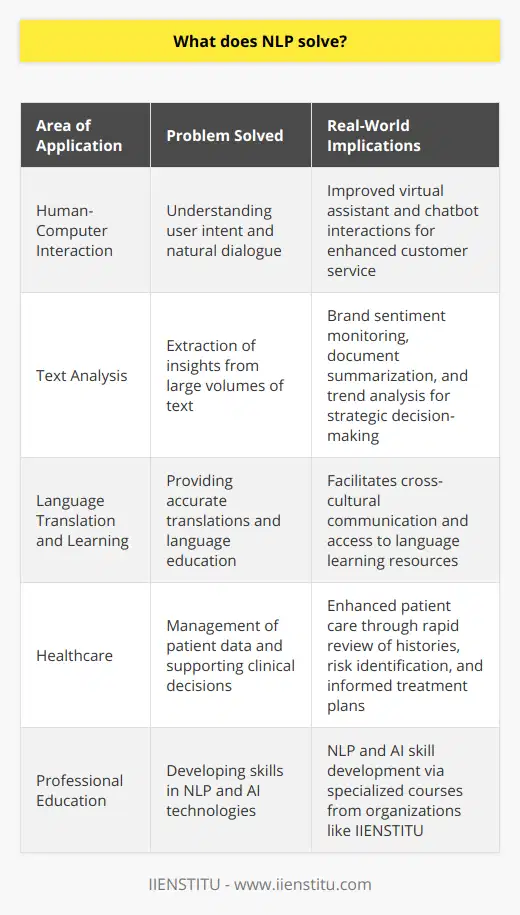
What are the three most common tasks addressed by NLP?
**Natural Language Processing Tasks**
In the realm of Natural Language Processing (NLP), numerous tasks enable machines to effectively comprehend, analyze, and generate human language. Three common tasks addressed by NLP involve sentiment analysis, named entity recognition, and machine translation.
**Sentiment Analysis**
Sentiment analysis, also known as opinion mining or emotion AI, examines the emotions and opinions expressed in a text. Through this process, NLP systems can determine the sentiment behind a statement as positive, negative, or neutral. This task is commonly employed for social media monitoring, market research, and customer feedback analysis, providing valuable insights for businesses and researchers alike.
**Named Entity Recognition**
Named entity recognition (NER) is an NLP task focused on the identification and classification of real-world entities within a text. These entities encompass proper nouns, such as names of people, organizations, and locations, as well as numeric expressions, including dates and amounts. The extraction of such information is vital for numerous applications, such as search engines, news summarization, and question-answering systems. Consequently, NER serves as a fundamental step in transforming unstructured text data into structured knowledge.
**Machine Translation**
One more prominent NLP task is machine translation, which involves the automated translation of text from one language to another. This task aims to break down language barriers and enable efficient communication between speakers of different languages. With advancements in deep learning and neural networks, machine translation systems have significantly improved in recent years. They allow for more accurate translations and better handling of idiomatic expressions and context nuances.
In conclusion, Natural Language Processing plays a crucial role in handling and understanding human language in various contexts. Sentiment analysis, named entity recognition, and machine translation are three common tasks that NLP systems are required to address in order to facilitate interaction and communication among users and unveil essential information for organizations and individuals alike.
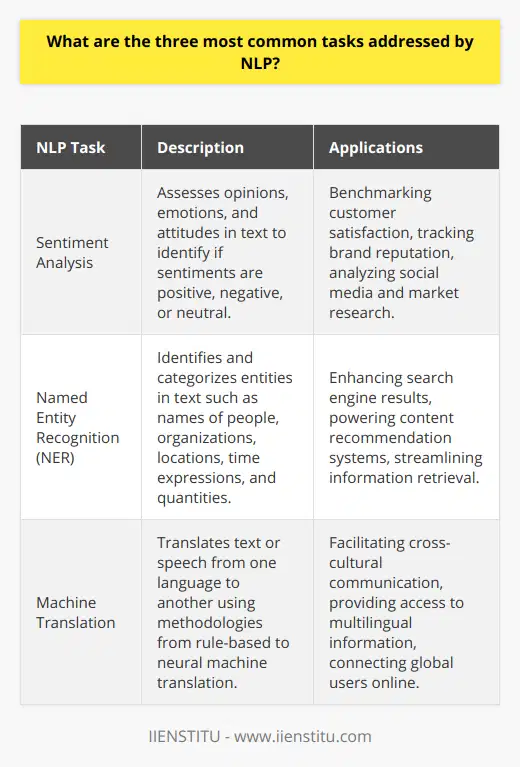
Which of the following is an example of an NLP problem?
**Defining NLP Problems**
Natural Language Processing (NLP) comprises various tasks aimed at understanding, generating, or translating human language using computer algorithms. Among many tasks, several examples of NLP problems include sentiment analysis, language translation, and named entity recognition. It is crucial to recognize these examples in order to optimize NLP solutions and applications.
**Sentiment Analysis**
Sentiment analysis is an NLP task that involves determining the sentiment behind a given text, whether it is positive, negative, or neutral. This problem is prominent in various fields, such as customer reviews, social media analysis, and marketing research. By employing NLP techniques, computers can automatically classify users' emotions or opinions towards certain subjects, products or services.
**Language Translation**
Another NLP problem is language translation, which seeks to convert text from one language to another while maintaining the original meaning. Machine translation systems, such as Google Translate, make use of NLP algorithms to decipher the syntactic and semantic structure of text in the source language and generate the corresponding text in the target language. This task is critical for communication, commerce, and global collaboration purposes.
**Named Entity Recognition**
Named entity recognition (NER) is an NLP problem that aims to identify and classify real-world objects, such as people, organizations, and locations, within a text. NER is a building block for more advanced NLP tasks, like information extraction and question-answering systems. By incorporating NER techniques, computers can understand and process unstructured data, identifying relevant pieces of information from news articles, social media posts, or any textual content.
In conclusion, there are numerous examples of NLP problems depending on the specific requirements and applications. Sentiment analysis, language translation, and named entity recognition are three significant instances of NLP tasks that demonstrate the importance and potential of NLP algorithms in making sense of human language and achieving effective communication in various fields.
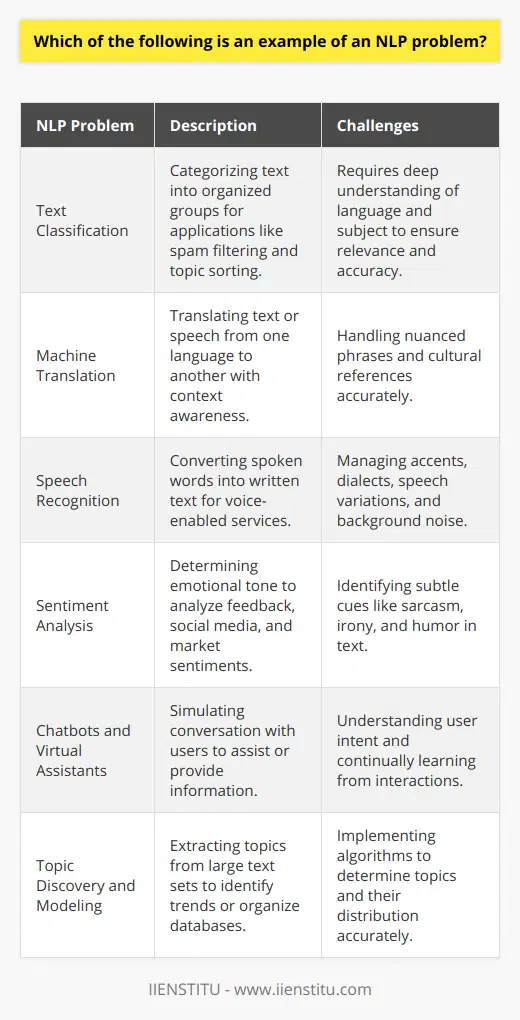
What is one of the major uses of NLP in academia?
Major Use of NLP in Academia: Research Support
Natural Language Processing (NLP) benefits academia through various applications, with one major use being research support. NLP tools streamline and enhance research processes, making it easier for scholars to manage and analyze large amounts of textual data.
Efficient Data Management
NLP techniques help in automating data management tasks, such as information retrieval and text classification. Researchers use these methods to efficiently sift through vast repositories, identify relevant documents, and categorize them based on specific criteria.
Improved Literature Review
NLP algorithms assist researchers in conducting comprehensive literature reviews. With keyword extraction and topic modeling, scholars quickly discover central themes in related works, providing a broader picture of the research landscape.
Sentiment Analysis and Opinion Mining
By performing sentiment analysis and opinion mining, NLP enables the evaluation of public opinion regarding a particular topic or issue. This insight aids researchers in identifying potential research gaps and understanding diverse perspectives in their field.
Text Summarization
Automatic text summarization allows researchers to quickly access the main ideas within a document. This capability saves time in reading and reviewing vast quantities of text, allowing scholars to focus on critical analysis and interpretation.
Automated Citation Discovery
NLP proves instrumental in identifying citations in academic papers automatically. This functionality contributes to effective sourcing and reference management, ensuring thorough documentation of scholarly work.
Semantic Text Similarity
Through semantic text similarity detection, NLP aids researchers in identifying similar content across various documents. Consequently, scholars can discover redundancies, ensure appropriate attribution, and prevent plagiarism in their work.
In conclusion, the major use of NLP in academia is providing research support through efficient data management, literature review assistance, sentiment analysis, text summarization, citation discovery, and semantic similarity detection. By leveraging NLP tools, scholars can enhance their research processes and focus on generating valuable insights and knowledge.
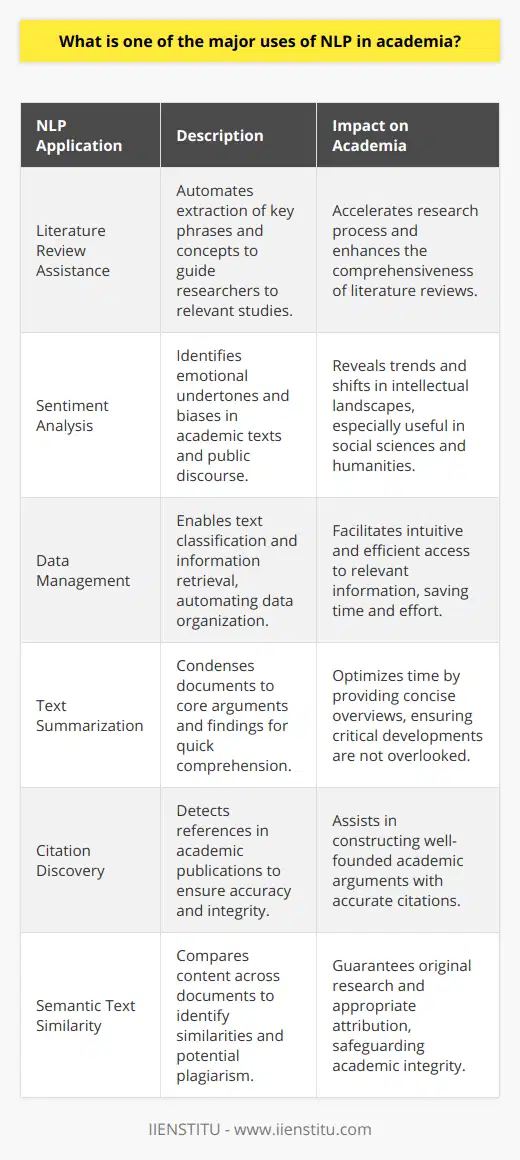
In what ways can NLP enhance our understanding of historical texts?
Enhancing Interpretation and Analysis
Natural Language Processing (NLP) can significantly enhance our understanding of historical texts by aiding in the interpretation and analysis process. Through the use of algorithms and computational tools, NLP can help researchers identify patterns, trends, and themes present in large volumes of historical documents. This improved interpretation increases the efficiency and comprehensiveness of our understanding of the past, providing new insights and allowing historians to develop nuanced arguments by drawing from an extensive body of textual evidence.
Contextual Understanding and Semantic Relationships
Additionally, NLP can improve our understanding of historical texts by providing contextual understanding and revealing semantic relationships between words and phrases. By analyzing the corpus of historical texts, NLP can make broader connections, helping us understand the usage of words and phrases in their original context, thus improving our comprehension of the material. This deeper understanding brings to light previously undiscovered information or connections that can reshape our view of past events and historical periods.
Sentiment Analysis and Emotional Context
One exciting application of NLP in understanding historical texts is sentiment analysis. By examining texts for emotive language, tone, and sentiment, NLP can help researchers uncover the societal mood, political atmosphere, or cultural context of a specific time period. This emotional context enriches our understanding of historical events and trends by adding an essential human element to the textual analysis.
Machine Translation and Cross-Lingual Analysis
Finally, NLP can improve our understanding of historical texts by facilitating machine translation and cross-lingual analysis. This feature enables scholars to access and analyze texts written in different languages, broadening the scope of their research and allowing for a more comprehensive understanding of global historical trends. Machine translation powered by NLP can also help overcome challenges posed by language evolution, archaic spellings, or regional dialects, thus increasing the accessibility of historical texts to a wider audience.
In conclusion, NLP offers valuable tools to enhance our understanding of historical texts by aiding in interpretation and analysis, providing contextual understanding, enabling sentiment analysis, and facilitating machine translation. These applications not only improve the accessibility and comprehensiveness of historical research but also foster a deeper understanding of the human experiences that shape the past.
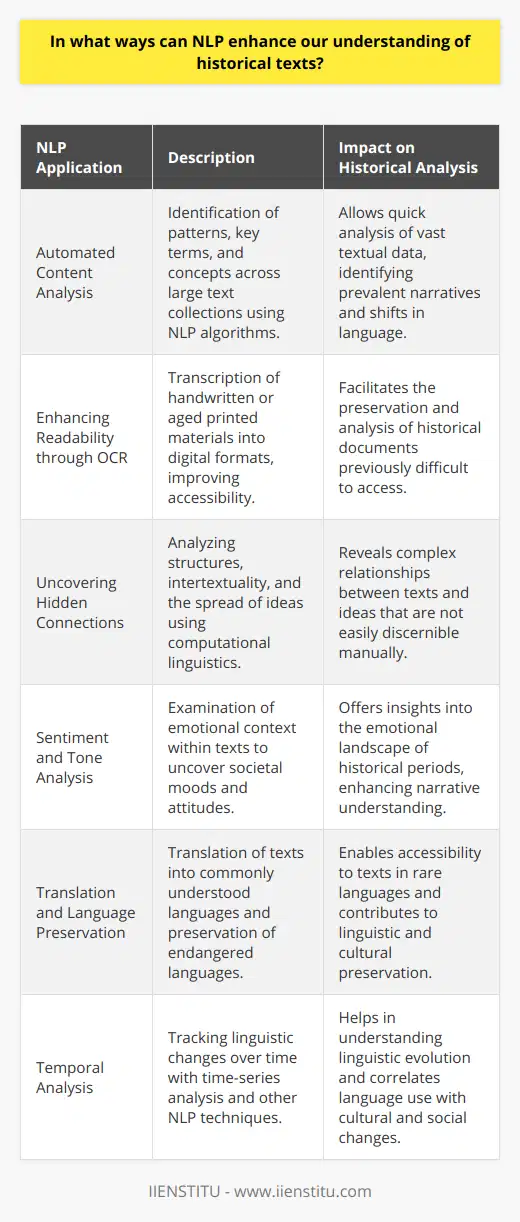
How has NLP contributed to advancements in artificial intelligence research?
**NLP's Impact on AI Research**
Natural Language Processing (NLP) has significantly contributed to advancements in artificial intelligence (AI) research. As a subfield of AI, it focuses on enabling computers to understand, interpret, and generate human language. NLP has led to numerous breakthroughs in various AI research domains.
**Enhancing Human-Machine Interaction**
One of the key advancements arising from NLP research is the improvement in human-machine interaction. NLP techniques enable AI systems to understand natural human language better, thus leading to more effective communication. This has facilitated the emergence of sophisticated digital assistants, such as Siri and Alexa, that can understand and assist users through a seamless, intuitive interface.
**Text Mining and Information Extraction**
Another essential contribution of NLP to AI research is in the area of text mining and information extraction. NLP allows AI systems to analyze large volumes of unstructured text data, efficiently extracting relevant insights and knowledge. This ability has transformed various fields, including business intelligence, social media analytics, and scientific research, by unlocking the vast informational potential present in textual data.
**Automated Translation and Language Understanding**
NLP has vastly improved machine translation and language understanding capabilities, paving the way for AI systems that can translate text or speech in real-time. This reduces language barriers, facilitates cross-cultural communication and understanding, and creates new opportunities for global collaboration. Additionally, the advancement in sentiment analysis and emotion detection allows AI systems to better understand and respond to human emotions.
**Supporting Accessibility and Inclusivity**
Finally, NLP's advancements have made significant strides in supporting accessibility and inclusivity. AI systems that leverage NLP techniques can provide essential services to individuals with disabilities, such as speech recognition, text-to-speech conversion, and real-time captioning. These applications enhance accessibility and increase independence for people with varying needs.
In conclusion, NLP's advancements have played a vital role in driving AI research forward. By focusing on understanding and generating human language, NLP has resulted in better human-machine interaction, more efficient information extraction, innovative language understanding tools, and improved accessibility for people with disabilities. These achievements not only propel AI research but also promise a more inclusive and interconnected future.
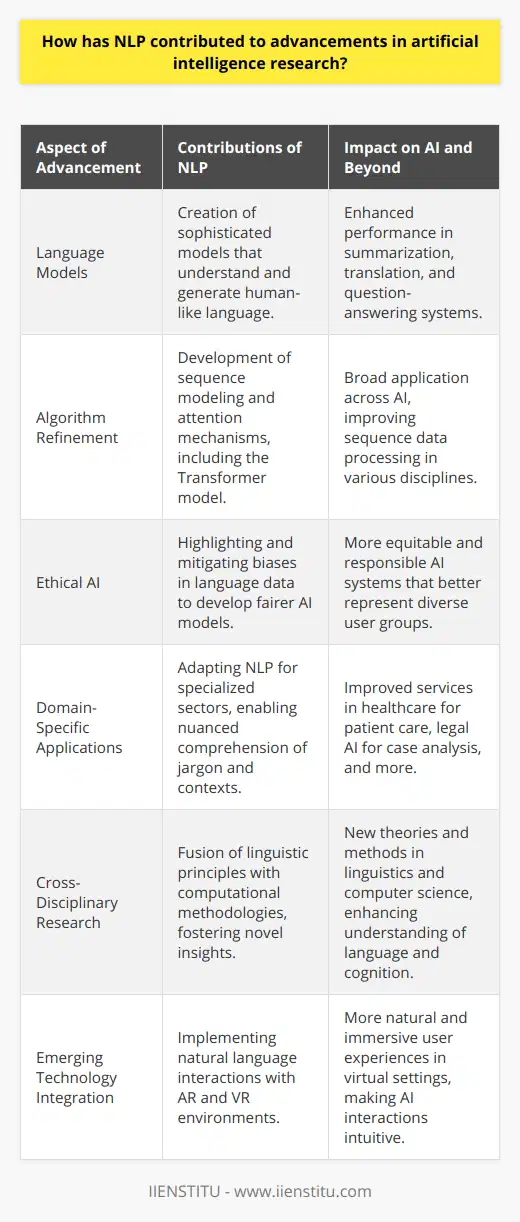
What are some key challenges faced in the development and implementation of NLP techniques?
Challenges in NLP Development and Implementation
Data Scarcity and Quality
One of the main challenges in developing and implementing natural language processing (NLP) techniques is the scarcity and quality of data. Real-world textual data is often unstructured, diverse, and inconsistent, making it difficult for rule-based or statistical methods to generalize and adapt efficiently. Furthermore, obtaining a sufficient amount of labeled data for supervised learning can be time-consuming and expensive.
Ambiguity and Context Sensitivity
Ambiguity is inherent in natural language, which often results in unclear or multiple meanings. NLP algorithms must be able to distinguish between different interpretations of homonyms, synonyms, and polysemous terms to accurately understand the intended meaning. Context sensitivity is another factor that complicates the task as the meaning of words can vary depending on situational factors and surrounding text, requiring complex models to deduce context.
Variability in Language Structure
Human language is dynamic and differs in structure across dialects, registers, sociolects, and languages. NLP techniques must manage these variations and adapt to changing trends in syntax, vocabulary, and semantics. Moreover, NLP models need to account for the subtlety and nuance associated with idiomatic expressions, metaphors, and indirect speech acts, as these complexities pose difficulties in accurately modeling language.
Resource Imbalance Among Languages
NLP research and tools primarily focus on widely spoken languages, such as English, Chinese, and Spanish, leaving low-resource languages with limited support. Developing techniques for these underrepresented languages is challenging due to insufficient linguistic resources and data, hindering the growth of multilingual and cross-lingual NLP applications.
Ethical Considerations and Bias
Ethical issues and biases present significant challenges when developing NLP systems. Biases ingrained in textual data, such as gender, racial, or political bias, can propagate through NLP models and lead to unfair or inaccurate outcomes. Addressing these biases to ensure fair, transparent, and responsible algorithms is integral to the sustainable development of NLP techniques.
Computational Complexity and Performance
NLP tasks involve significant computational complexity, often requiring large-scale machine learning models, vast amounts of data, and substantial computational power. Ensuring the performance and efficiency of these models, especially for real-time applications, is essential for widespread NLP adoption.
In conclusion, developing and implementing NLP techniques involves overcoming considerable challenges. Bridging the data scarcity, accounting for language ambiguity and diversity, mitigating bias and ethical concerns, and balancing computational complexity with model performance are crucial aspects in advancing the field of NLP.
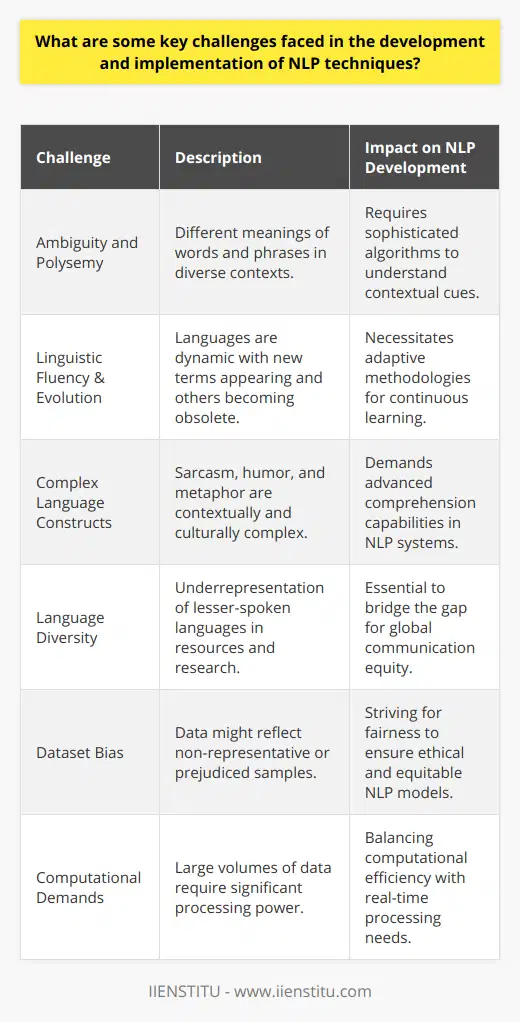
How does NLP improve machine-human interaction and comprehension in various industries?
Enhancing Communication
Natural Language Processing (NLP) significantly improves machine-human interaction and comprehension across various industries, mainly by enhancing bidirectional communication between machines and humans. With the advances in NLP, machines can now understand and interpret human language more effectively, allowing users to communicate their needs, access information, and execute tasks in a more natural and intuitive manner. Additionally, NLP facilitates efficient text analysis, automating laborious and time-consuming tasks that would have otherwise required human effort.
Improving Customer Service
In the realm of customer service, NLP plays a crucial role in chatbots and virtual assistants, which are designed to provide users with immediate and personalized responses to their queries. This technology enables better understanding of customers' needs and preferences, allowing businesses to tailor their services accordingly. By automating responses to frequently asked questions and performing tasks more effectively, NLP reduces the workload on human operatives, which results in a more efficient customer service process overall.
Optimizing Sales and Marketing
NLP also contributes significantly to improvements in sales and marketing by analyzing vast amounts of text data. Through sentiment analysis, NLP can extract insights about customers' opinions and feelings on specific products, services, or brands. These insights help businesses make data-driven decisions on how to segment their target audience, improve their offerings, and ultimately increase customer satisfaction.
Streamlining Human Resources
The field of human resources greatly benefits from NLP, as it aids in automating the recruitment process. NLP algorithms analyze job descriptions and applicants' resumes to identify the most suitable candidates, essentially saving time and resources for hiring managers. Moreover, NLP can detect patterns in employee feedback and understand workplace sentiment, enabling organizations to proactively address concerns and improve overall employee experience.
Boosting Productivity
Lastly, NLP finds applications in various productivity tools, such as voice and text recognition software, which allow users to communicate seamlessly with their devices. Implementing NLP in these tools streamlines workflows, considerably reducing the time spent on manual data entry, document creation, and content organization. As a result, individuals and industries can enhance their overall efficiency and productivity.
In conclusion, Natural Language Processing improves machine-human interaction and comprehension across a wide range of industries. By enabling machines to better understand and communicate with humans, NLP technology facilitates the automation of repetitive tasks, enhances customer experience, optimizes marketing initiatives, and boosts workplace productivity. The adoption of NLP in various applications promises continued advancements in technology and sustained growth for businesses worldwide.
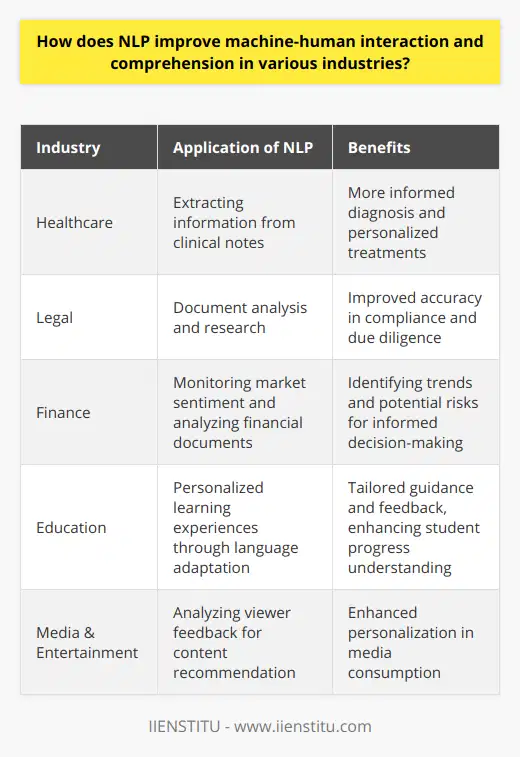
Can NLP techniques be utilized to overcome linguistic barriers and enhance multilingual communication?
NLP Techniques for Multilingual Communication
Natural Language Processing (NLP) techniques can indeed be utilized to overcome linguistic barriers and enhance multilingual communication. Being a subfield of artificial intelligence, NLP focuses on enabling computers to understand, interpret, and generate human language in a valuable and meaningful way.
Machine Translation Breaks Linguistic Barriers
A prime example of NLP techniques applied to facilitate multilingual communication is machine translation. Services like Google Translate use statistical models and neural networks to convert text from one language to another. As a result, conversations become more accessible between people who speak different languages, fostering global collaboration and inclusivity.
Sentiment Analysis Enhances Understanding
Another NLP application that supports multilingual communication is sentiment analysis. By identifying and evaluating emotions, opinions, and attitudes within textual data, NLP tools can assist users in grasping the general sentiment of foreign language content. This comprehension enables better engagement in cross-cultural dialogues and improved understanding of global perspectives.
Named Entity Recognition for Accurate Information Extraction
Named entity recognition (NER) is another valuable NLP technique in the context of multilingual communication. NER identifies and classifies entities such as names, locations, and organizations within text. Utilizing this technique ensures accurate information extraction and representation from multiple languages, thus assisting in overcoming linguistic barriers.
Language Identification and Detection
Before applying translation or NLP techniques, language identification is crucial in a multilingual environment. NLP tools can accurately detect and identify the language of a given text, which can then undergo suitable processing. This capability enables seamless communication in any language combination.
Part-of-speech Tagging Aids in Precision
Part-of-speech (POS) tagging is an essential foundation for many NLP techniques utilized in multilingual communication. By accurately assigning POS tags to words in different languages, NLP tools can create more precise translations and interpretations. Consequently, it allows for enhanced communication between diverse language speakers.
In conclusion, NLP techniques play a significant role in overcoming linguistic barriers and enhancing multilingual communication. The development in NLP applications such as machine translation, sentiment analysis, named entity recognition, language identification, and part-of-speech tagging has made it possible to bridge language gaps and enable comprehensive understanding in cross-cultural interactions.
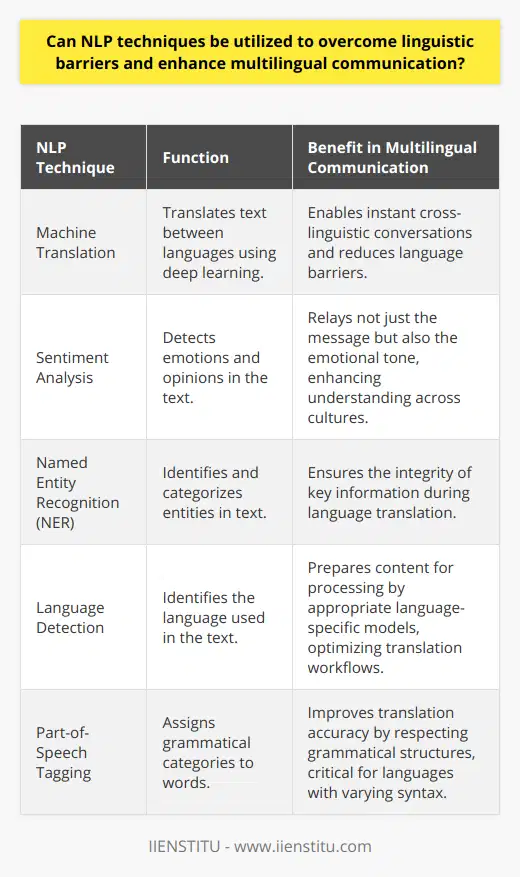
Which of the following is mostly used in NLP problems?
Topic: Most Commonly Used Techniques in NLP Problems
**Statistical and Neural Techniques**
In the field of Natural Language Processing (NLP), the utilization of various techniques is paramount to achieving efficient methods for tasks such as text classification, machine translation, and sentiment analysis. Among these approaches, statistical and neural techniques are most commonly utilized in resolving NLP problems.
**Statistical Techniques: N-grams and Hidden Markov Models**
Statistical techniques predominantly rely on the statistical properties of text data. One such popular method is the N-gram model, which considers context by dividing the text into sequences of N contiguous words or characters. These models are then used to compute word probabilities, allowing insight into the structure and pattern of the language. Another well-known technique is the Hidden Markov Model (HMM), specifically employed in part-of-speech tagging and named entity recognition tasks. HMMs help predict the most likely sequence of hidden states through observation data, leveraging the probability distributions of text data.
**Neural Techniques: Recurrent and Transformer Networks**
In contrast to statistical methods, neural techniques primarily use deep learning techniques for NLP tasks. One popular approach is the Recurrent Neural Network (RNN), which captures the sequential nature of text data by maintaining a hidden state that evolves over time. RNNs, especially their Long Short-Term Memory (LSTM) and Gated Recurrent Unit (GRU) variants, have proven effective in various NLP applications, including sentiment analysis and machine translation.
In recent years, the introduction of the Transformer architecture has brought about significant improvements in NLP tasks. This model employs self-attention mechanisms to weigh the importance of different words in a sentence, capturing long-range dependencies more effectively than RNNs. Prominent transformer-based models, such as BERT and GPT-3, have set new benchmarks across a variety of NLP tasks, including text generation and question-answering.
**Conclusion**
In conclusion, while both statistical and neural techniques are widely used in NLP problems, neural techniques have gained considerable traction in recent years. The ongoing advancements in deep learning models, specifically transformer-based architectures, promise further improvements in the field of Natural Language Processing. However, statistical methods still hold value in particular contexts and remain relevant in specific NLP applications.
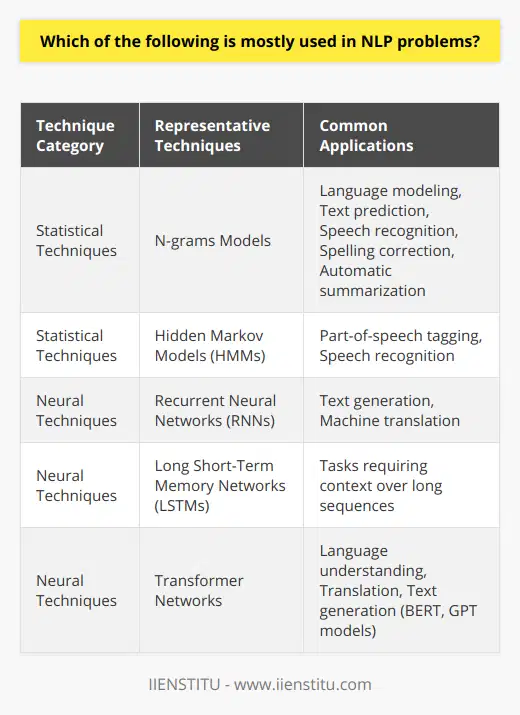
How has NLP facilitated greater accessibility and understanding of information in global digital communication?
Enhancing Global Communication
Natural Language Processing (NLP) has significantly improved accessibility and understanding of information in global digital communication through various applications. These innovations have addressed language barriers, facilitated content analysis, and personalized user experiences.
Breaking Language Barriers
One notable NLP application is real-time machine translation, which has enabled individuals to communicate across different languages effectively. This technology has allowed people to access and comprehend essential information irrespective of their linguistic background. For instance, tools such as Google Translate and Microsoft Translator have made it easier to understand foreign websites, social media posts, and electronic publications.
Empowering Content Analysis
Moreover, NLP has facilitated faster and more accurate content analysis in large volumes of text data. Sentiment analysis, topic modeling, and text summarization are examples of popular techniques that are utilized to analyze digital communication. By automating these processes, researchers and organizations can now quickly identify patterns, trends, and themes in unstructured text information, leading to enhanced decision-making and understanding of global digital communication.
Personalizing User Experience
Lastly, NLP has made it possible to offer personalized user experiences through dialogue systems, also known as chatbots. These AI-driven applications understand the user's intent by analyzing their natural language queries and providing relevant responses. By tailoring conversations to individual preferences, chatbots have dramatically improved customer service, e-commerce, and online interactions among users from different parts of the world.
In conclusion, NLP has played a pivotal role in enhancing accessibility and understanding of information in global digital communication by overcoming language barriers, enabling efficient content analysis, and delivering personalized user experiences. As NLP continues to advance, it will further revolutionize how we communicate and consume information globally, fostering a more interconnected world.
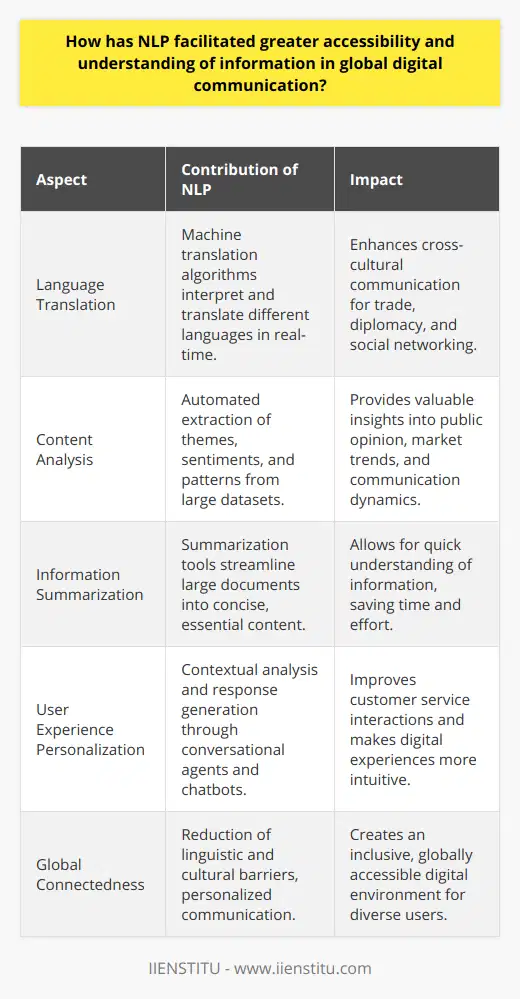
What is the role of NLP in the development of recommender systems and targeted advertising?
Role of NLP in Recommender Systems
Natural Language Processing (NLP) plays a significant role in the development of recommender systems by analyzing user-generated data. These systems depend on NLP techniques to extract relevant information, understand user preferences, and provide personalized recommendations. NLP contributes to the accuracy and efficiency of these systems by understanding the context, sentiment, and semantics within text data.
Sentiment Analysis for Preference Detection
In targeted advertising, understanding user sentiment is crucial. NLP techniques such as sentiment analysis enable businesses to gauge consumers' opinions, feelings, and attitudes towards products, services, or brands. By doing so, they can tailor advertisements to resonate with the target audience, increasing the likelihood of conversion.
Text Classification for Improved Recommendations
Text classification, another NLP technique, helps in categorizing user-generated content. This allows for easy filtering and organization of information, aiding recommender systems in offering more accurate recommendations. For instance, content can be classified based on its genre, allowing users to receive recommendations of products or services they have shown an interest in before.
Topic Modeling for Enhanced Targeting
Topic modeling is an NLP approach used to discover hidden patterns within large volumes of text data. In the context of recommender systems and targeted advertising, this method enhances targeting accuracy by allowing businesses to identify common themes and trends within their audience. Based on these insights, advertisers can create relevant and engaging content that appeals to users, increasing customer satisfaction and brand loyalty.
Personalization and User Engagement
NLP-based recommender systems contribute to better personalization of content, leading to increased user engagement. Through the analysis of user-generated text data, businesses can understand individual preferences and behaviors, enabling them to provide customized recommendations and advertisements. This personalized approach makes users feel valued, resulting in higher engagement and satisfaction.
In conclusion, NLP plays a pivotal role in the development of recommender systems and targeted advertising. The techniques it employs, such as sentiment analysis, text classification, and topic modeling, enhance the effectiveness and personalization of these approaches, leading to better user experiences and greater business success.
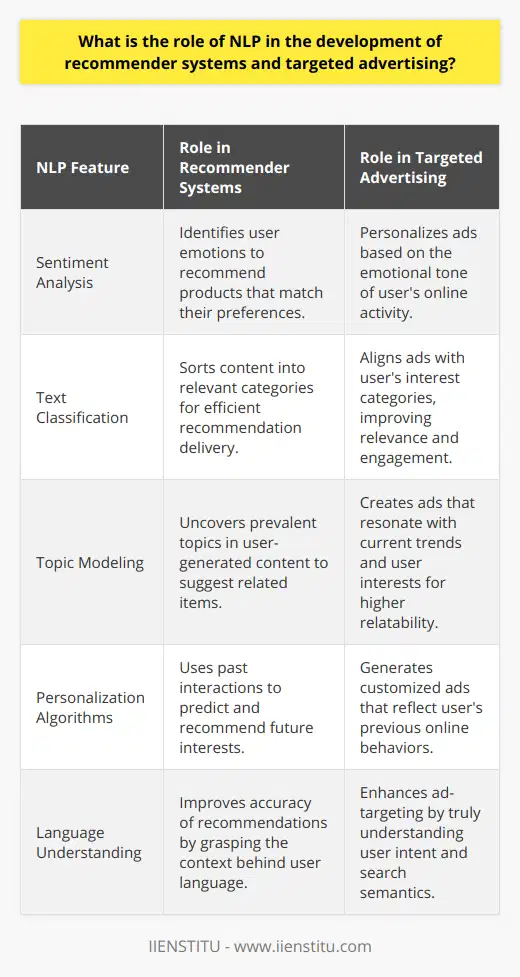
Which of the following tasks best demonstrates the application of NLP in sentiment analysis?
**NLP and Sentiment Analysis**
Natural Language Processing (NLP) has been instrumental in enabling computers to analyze, understand, and generate human language. Among the many tasks that NLP addresses, sentiment analysis stands out as an especially valuable application.
**Sentiment Analysis Applications**
In the realm of sentiment analysis, NLP finds practical usage in various tasks, including evaluating social media content, analyzing customer feedback, and determining market trends. However, the task that best illustrates the application of NLP in sentiment analysis is arguably the extraction and assessment of emotions, opinions, and attitudes from text-based sources.
**Emotion, Opinion, and Attitude Extraction**
This particular task involves processing text data, such as reviews, comments, or social media posts, to identify and classify the underlying sentiment as positive, negative, or neutral. NLP techniques, including tokenization, POS tagging, and parsing, help machines understand the context of the text and recognize linguistic cues that indicate sentiment.
**Sentiment Classification**
Once the key sentiment components are extracted, NLP deploys machine learning algorithms, including Naive Bayes, Support Vector Machines, and Deep Learning methods, to classify the sentiment accurately. These models rely on pre-existing datasets, which are typically annotated with sentiment labels for supervised training of the algorithms.
**Challenges and Enhancements**
Despite the steady progress in sentiment analysis, certain challenges remain, such as handling negations, sarcasm, or slang. In response, NLP researchers are constantly refining algorithms and techniques to overcome these obstacles and improve sentiment analysis accuracy.
**In Summary**
In conclusion, the task of extracting and evaluating emotions, opinions, and attitudes best demonstrates the application of NLP in sentiment analysis. By processing text data and employing machine learning methods, NLP allows for a powerful way to classify and assess sentiments, while continually striving to overcome the challenges that arise.
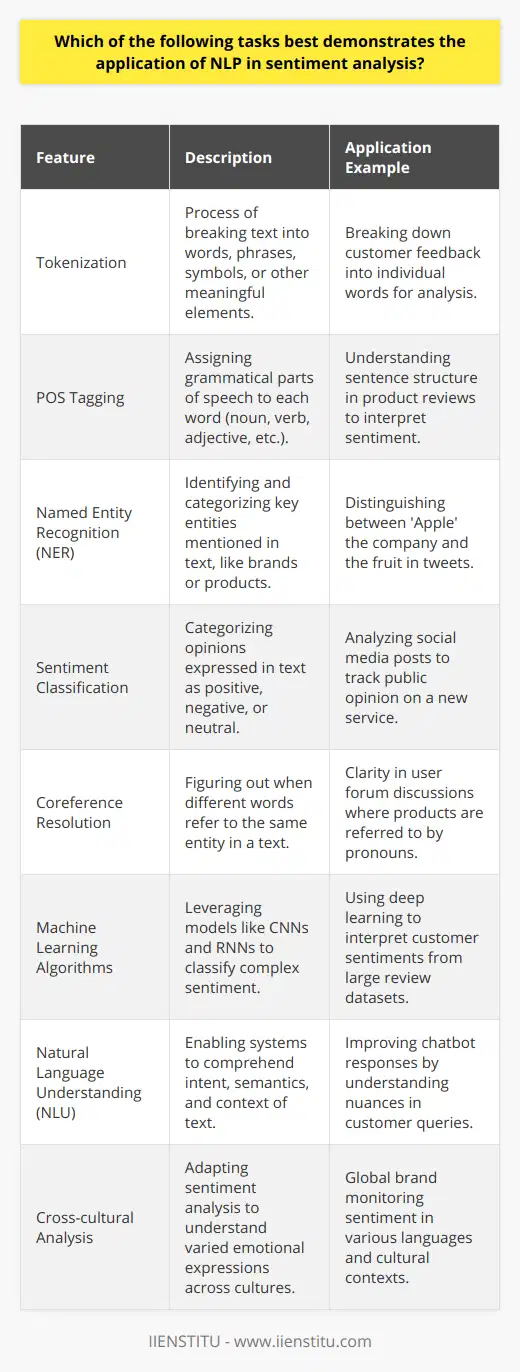
How has NLP contributed to the improvement of machine translation between different languages?
Contribution to Lexical Analysis
Natural Language Processing (NLP) significantly contributes to machine translation (MT) by enhancing various tasks within this field. NLP improves lexical analysis, which is essential for accurately converting source text into target languages. It achieves this by identifying the morphological structure of words and processing them accordingly. Moreover, NLP incorporates a vast knowledge of multiple languages, thus improving translation quality across numerous linguistic pairs.
Syntactic and Semantic Interpretation
NLP further bolsters MT by facilitating syntactic and semantic interpretation in the translation process. It efficiently analyzes the grammatical structure of sentences, ensuring proper word order and construction in the target language. This crucial capability promotes coherence in translated text. Additionally, NLP enables accurate semantic interpretation via specialized algorithms designed to identify relationships between terms and concepts. This aids in conveying the intended meaning even when idiomatic expressions or cultural nuances are involved.
Machine Learning Integration
Machine learning (ML) integration has also considerably improved MT, as NLP can leverage data-driven algorithms for enhanced translation performance. By utilizing vast quantities of bilingual texts, MT systems learn to identify patterns and generalize across various language pairs. This allows for continual improvements in translation quality as new data sets become available. Consequently, ML-based NLP techniques such as neural machine translation (NMT) have emerged as a dominant approach in current MT systems.
Handling Ambiguity and Context
Lastly, NLP contributes to MT by effectively handling linguistic ambiguity and capturing context. Context-sensitive translation, achieved by analyzing surrounding text and prioritizing relevant meanings, results in coherent and high-quality translations. NLP techniques such as anaphora resolution ensure correct interpretation of pronouns and their antecedents, while automated disambiguation selects suitable target-language representations for polysemous terms. Additionally, NLP aids in resolving orthographic ambiguity, thus producing accurate translations in languages with complex writing systems.
In conclusion, NLP has provided valuable contributions to MT by improving lexical analysis, facilitating syntactic and semantic interpretation, incorporating ML integration, and handling ambiguity and context. Collectively, these enhancements have resulted in higher-quality translated text, fostering efficient communication across linguistic boundaries.
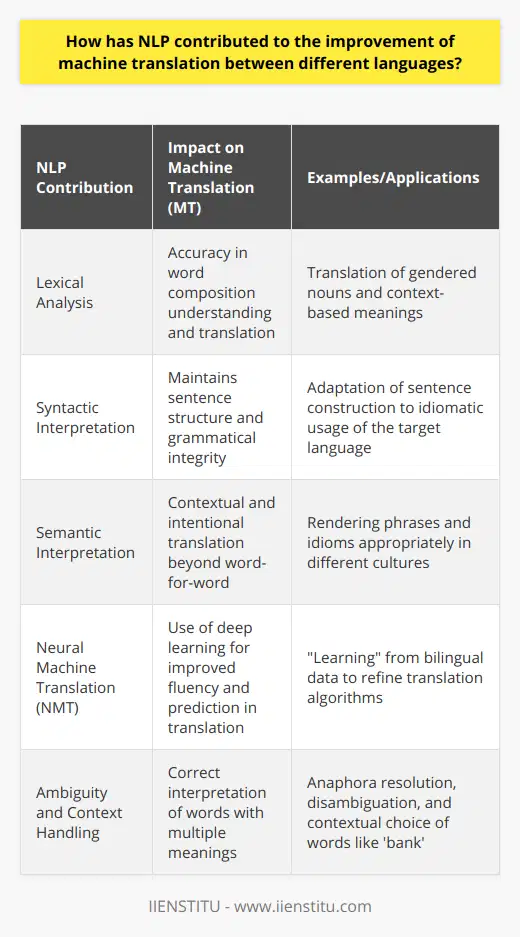
How does NLP facilitate the extraction of relevant information from large and complex datasets in various fields?
The Significance of NLP
Natural Language Processing (NLP) plays a critical role in extracting relevant information from large and complex datasets in various domains. It facilitates the analysis and understanding of human languages, thereby enabling the retrieval of meaningful data. In this paragraph, we discuss two main processes where NLP demonstrates its capabilities in handling voluminous datasets: text categorization and sentiment analysis.
Text Categorization
Text categorization is a process that assigns predefined labels to text documents. NLP-powered algorithms can analyze extensive datasets and identify patterns and relationships within the text. This process aids in clustering similar documents, making information retrieval more efficient. Consequently, text categorization contributes to organizing large datasets into smaller, more comprehensible groups, allowing researchers and experts to navigate the information quickly and accurately.
Sentiment Analysis
Another area where NLP excels is sentiment analysis. Sentiment analysis, also known as opinion mining, involves determining the sentiment or emotion expressed in a text. NLP techniques identify and categorize opinions based on their polarity: positive, negative, or neutral. As a result, sentiment analysis helps in extracting valuable insights from vast datasets, particularly in fields such as marketing research, customer feedback analysis, and social media monitoring. By understanding the sentiments of users or customers, businesses and researchers can make informed decisions and develop better strategies.
In conclusion, NLP serves as a crucial tool in facilitating the extraction of relevant information from large and complex datasets. Its ability to categorize texts and analyze sentiments significantly contributes to the comprehension and usability of the data in various fields. By employing NLP techniques, researchers and professionals can more efficiently navigate and interpret the wealth of available information, leading to valuable insights and better decision-making.
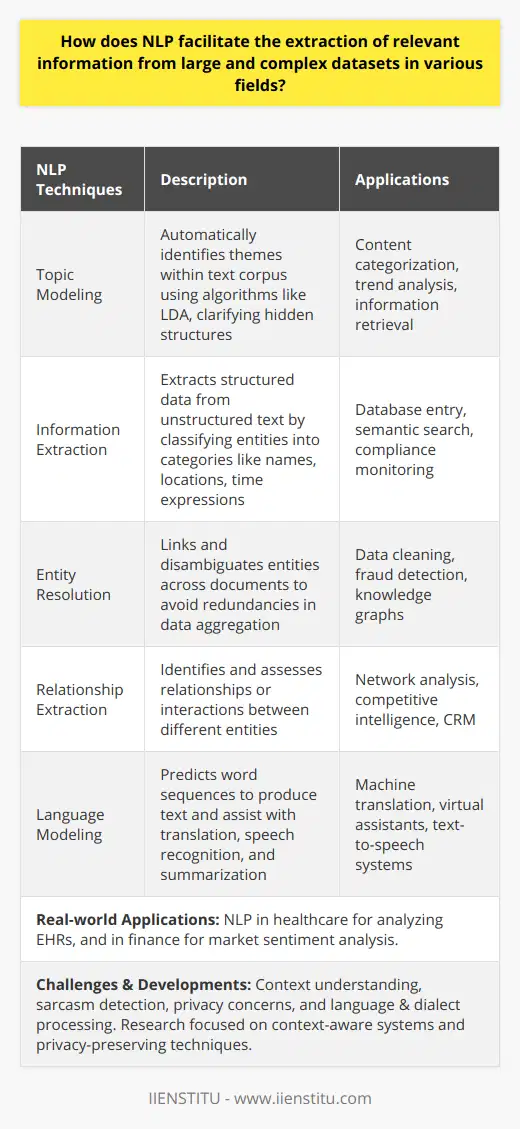
What is a common example of NLP in the context of information retrieval and search engine optimization?
Common Example: Keyword Analysis
Natural Language Processing (NLP) in Information Retrieval
A common example of NLP in the context of information retrieval and search engine optimization is keyword analysis. Keyword analysis encompasses the identification, evaluation, and optimization of words and phrases in a text corpus relevant to a search query. Consequently, it plays a critical role in facilitating high-quality search results and website ranking in search engines like Google, Bing, and Yahoo.
Exploiting NLP for Effective SEO Strategies
NLP-powered keyword analysis provides insights into the significance and relevance of specific keywords in relation to the target audience's needs and preferences. Moreover, NLP algorithms can deduce contextual information and determine semantic relationships among words, enhancing the search query's precision and relevance. By incorporating NLP techniques into SEO strategies, content creators and marketers can optimize their content by using pertinent keywords, improving the content's visibility and user engagement.
Role of Keyword Density and Distribution
One crucial aspect of keyword analysis is keyword density, which refers to the frequency of a keyword appearing in a text relative to its total word count. While excessive keyword usage, known as 'keyword stuffing,' can lead to penalties, maintaining an appropriate keyword density can boost a website's ranking. Additionally, even keyword distribution ensures the content remains coherent and easily comprehensible for readers, resulting in improved website engagement.
Improving Search Engine Ranking with NLP
Using NLP for keyword analysis results in a better understanding of user intent and allows content creators to craft content that aligns with their target audience's preferences. Furthermore, search engines continually evolve, incorporating advanced NLP techniques to assess and rank websites. Consequently, adopting NLP methodologies for keyword analysis and SEO helps businesses create user-focused content that is more likely to achieve higher search engine rankings.
In conclusion, NLP's application in keyword analysis is vital in optimizing content for search engines and enhancing user experience. It provides content creators with insights into keyword significance, allowing them to make informed decisions regarding keyword usage and distribution. Ultimately, leveraging NLP in search engine optimization strategies leads to higher rankings and greater online visibility.
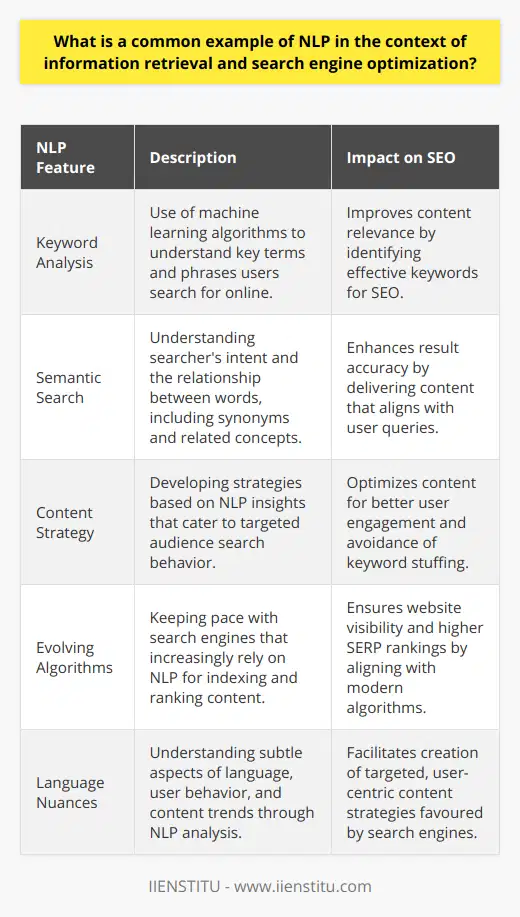
How do NLP techniques support the analysis and interpretation of social media data for opinion mining and sentiment analysis?
NLP Techniques in Social Media Analysis
The advent of social media has resulted in an overwhelming volume of user-generated content, rendering manual analysis of such data impractical. Natural Language Processing (NLP) techniques play a critical role in automating the analysis and interpretation of this data, specifically in the fields of opinion mining and sentiment analysis.
Understanding Textual Data
Through NLP techniques, textual data from social media posts can be understood and analyzed, enabling the extraction of opinions and emotions expressed by users. Sentiment analysis, a crucial application of these techniques, involves determining the sentiment polarity (positive, negative, or neutral) of a given text. This is achieved by employing algorithms to process and interpret these large textual datasets.
Machine Learning Approaches
Machine learning approaches, such as supervised and unsupervised learning, form the backbone of NLP-enabled sentiment analysis. Supervised learning, in particular, leverages pre-labeled training data to create models that can classify text according to sentiment. In contrast, unsupervised learning relies on clustering algorithms to identify patterns and sentiments without pre-defined labels.
Feature Extraction and Representation
Successful sentiment analysis hinges on the ability to effectively extract and represent relevant text features. NLP techniques such as tokenization, stemming, and text normalization enable the identification of meaningful text segments. Additionally, the use of techniques like Bag of Words (BoW), Term Frequency-Inverse Document Frequency (TF-IDF), and word embeddings ensure an accurate representation of the extracted features.
Sentiment Lexicons and Rule-Based Systems
Sentiment lexicons further complement NLP-based social media analysis by providing repositories of opinion-carrying words, each associated with a sentiment score. Rule-based systems, in tandem with these lexicons, generate sentiment scores by analyzing the prevalence and context of opinion-carrying words within a text.
Contextual Analysis and Aspect-Based Sentiment Analysis
More advanced NLP techniques facilitate contextual and aspect-based sentiment analysis by capturing nuanced expressions and sentiments associated with specific aspects or features. Dependency parsing and named entity recognition, for instance, allow for the identification and assessment of sentiment-bearing phrases, offering rich insights into diverse opinions and detailed evaluations.
In conclusion, NLP techniques are instrumental in automating and streamlining the process of mining opinions and sentiments from social media data. Through various approaches and techniques, they facilitate the extraction, representation, and analysis of textual data, providing valuable insights into public opinion trends, consumer preferences, and overall sentiment.
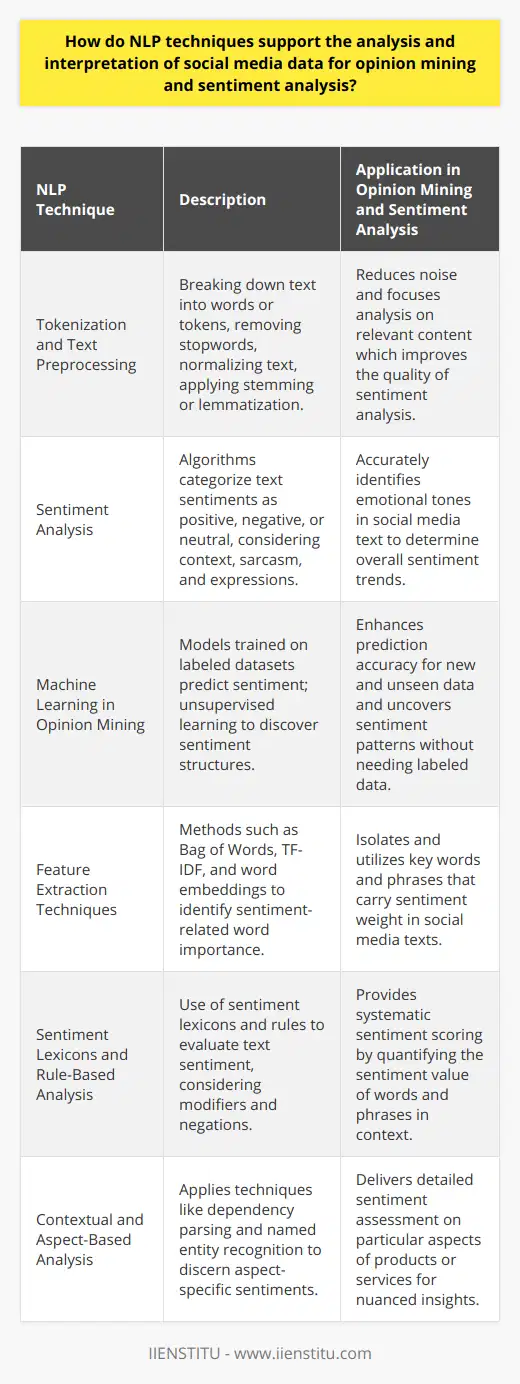
In the context of computational linguistics, what are some key limitations of NLP when dealing with idiomatic expressions and figurative language?
Challenges in Identifying Idiomatic Expressions
One key limitation in natural language processing (NLP) while handling idiomatic expressions is the difficulty in recognizing them as non-literal expressions. Idioms, being context-dependent and culturally specific, often exhibit unique meanings unrelated to the individual words they contain. Furthermore, idiomatic expressions can be polysemous, giving rise to multiple interpretations depending on the context.
Difficulties in Disambiguating Figurative Language
Another challenge posed to NLP systems comes in disambiguating figurative language such as metaphors, similes, and irony. Figurative language often relies on implicit meanings and shared knowledge rather than explicit literal meanings. Developing algorithms that discern implied meanings, sarcasm, and irony remains a complex task for computational linguistics.
Lack of Extensive Training Data
The lack of extensive, high-quality annotated training data further complicates NLP’s ability to understand idiomatic and figurative language. Machine learning models, which often require large datasets to achieve optimal performance, struggle to recognize the nuances of context and cultural knowledge necessary for accurate interpretation of idiomatic expressions.
Cross-lingual and Cultural Considerations
NLP also encounters difficulties in translating and interpreting idiomatic expressions and figurative language across different languages and cultures. Direct translations often result in nonsensical or misleading interpretations, as idiomatic expressions are deeply rooted in their native cultural and linguistic contexts. Computational linguistics must tackle the challenge of accurately mapping such expressions to suitable equivalents in the target language, considering both linguistic and cultural contexts.
In conclusion, NLP faces significant challenges when dealing with idiomatic expressions and figurative language. Identifying non-literal expressions, disambiguating figurative language, addressing the lack of extensive training data, and navigating cross-lingual and cultural considerations represent some of the key limitations in the field of computational linguistics.
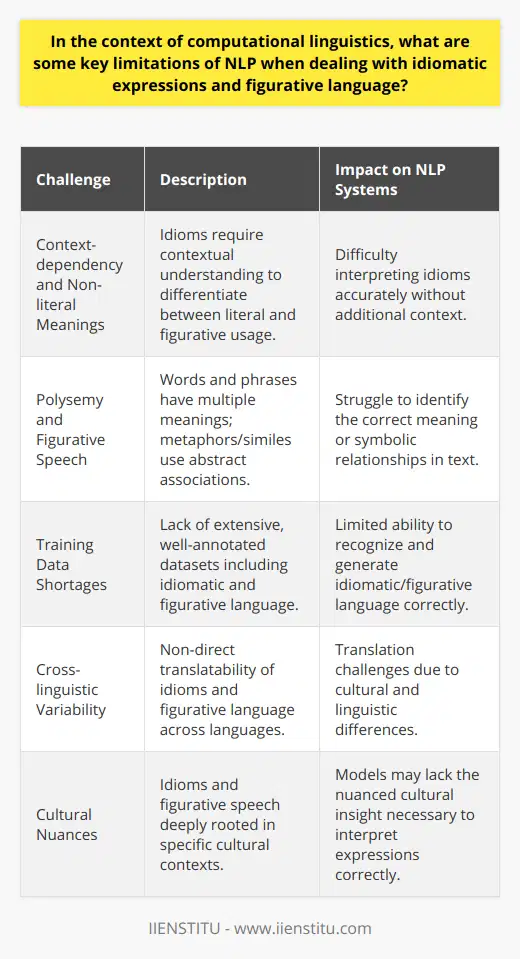
What problems can be solved by NLP?
**Challenges Addressed by NLP**
Natural Language Processing (NLP) is a subfield of artificial intelligence that aims to improve human-computer interactions by enabling machines to better understand and interpret human languages. By developing advanced algorithms, NLP can help solve numerous practical problems across a variety of domains.
**Information Retrieval and Filtering**
One key problem NLP tackles is information retrieval, particularly from unstructured data. It allows search engines to refine and rank search results based on relevance and context, ensuring users receive pertinent information. Moreover, NLP supports spam detection in emails by analyzing textual patterns and filtering out unwanted messages.
**Machine Translation and Language Understanding**
Machine translation is another issue addressed by NLP. By employing translation models, it can provide accurate, context-aware translations that bridge language barriers. Additionally, NLP enables the creation of language models that incorporate syntactic and semantic understanding, enhancing the capabilities of personal digital assistants and voice assistants.
**Sentiment Analysis and Opinion Mining**
NLP can assess users' emotions, opinions, and attitudes by examining textual input. This sentiment analysis is valuable for businesses seeking customer feedback, political campaigns aiming to gauge public sentiment, and researchers studying online discourse. The automated analysis of large volumes of data provides insightful trends that can guide decision-making processes.
**Text Summarization and Paraphrasing**
Text summarization is a complex problem that NLP aims to solve. Automatically condensing large volumes of written information into succinct summaries aids in efficiently extracting and conveying vital information. Furthermore, NLP supports paraphrasing, enabling the conversion of complex sentences into simpler, more easily understood versions while retaining meaning.
**Vocabulary Expansion and Disambiguation**
Finally, NLP can help expand a language's vocabulary and improve disambiguation by interpreting abbreviations, slang, and new phrases. It can also discern the correct meaning of words with multiple meanings, allowing for clearer communication and fewer misunderstandings.
In summary, NLP offers diverse solutions to address various linguistic challenges, enhancing human-computer interaction and providing valuable tools for communication, analysis, and understanding. As NLP technology continues to advance, its potential for solving complex problems in numerous domains will undoubtedly grow.
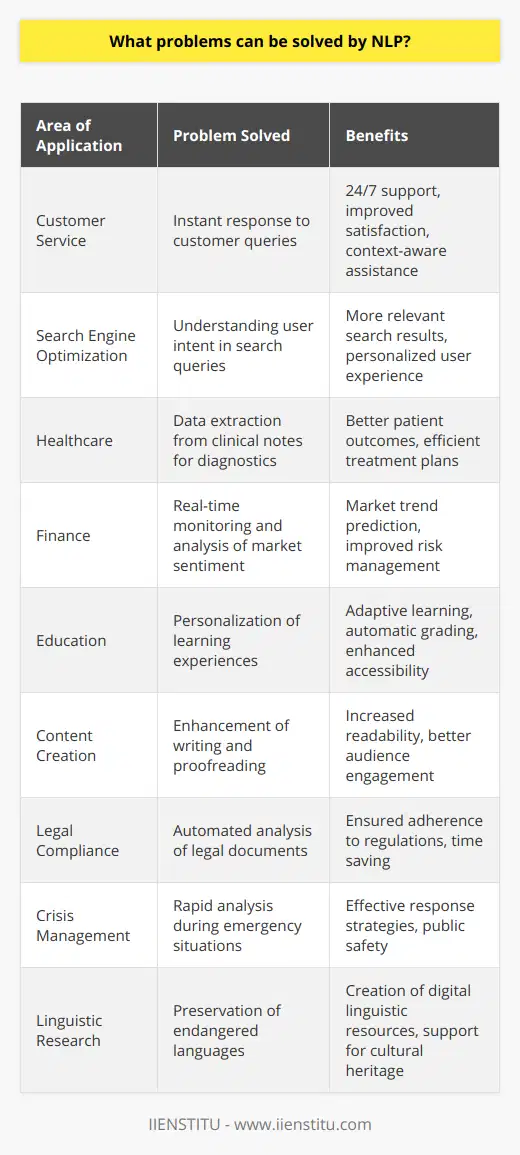
In what capacity does NLP contribute to the field of digital humanities, particularly in text analysis and corpus studies?
NLP Contributions to Digital Humanities
Natural Language Processing (NLP) plays a pivotal role in advancing the field of digital humanities, as it enables deeper examination and interpretation of diverse text data. Specifically, NLP contributes to text analysis and corpus studies through various capacities, such as information extraction, topic modeling, and sentiment analysis.
Enhancing Information Extraction
One of the primary ways in which NLP contributes to digital humanities is through information extraction. This process involves automatically identifying and extracting relevant pieces of information from unstructured text data. NLP techniques, such as named entity recognition, enable researchers to identify specific entities, like people, places, or organizations, within a text. These extracted features can then be analyzed in various ways, from examining their frequency and co-occurrence to investigating their relationships and significance in the larger context of the corpus.
Enabling Topic Modeling
Another vital aspect of NLP's contribution to digital humanities is its role in topic modeling. Topic modeling involves uncovering the underlying themes or topics within a corpus, which can be especially useful in analyzing large collections of text data. By using NLP algorithms like Latent Dirichlet Allocation (LDA), researchers can identify clusters of words that frequently occur together, forming topics. This capacity allows digital humanists to explore the dominant themes and discourses within a text or across multiple texts, often revealing novel insights and patterns that would be difficult to discern otherwise.
Facilitating Sentiment Analysis
Finally, sentiment analysis plays a significant role in NLP's impact on digital humanities. Using NLP techniques, researchers can classify the sentiment or emotion expressed in a given text, determining whether it is positive, negative, or neutral. This capability is particularly advantageous in the study of cultural and historical texts, as it allows scholars to analyze shifts in prevailing attitudes and emotions over time. By tracking sentiment trends in large-scale corpora, digital humanists can gain valuable insights into public opinion, ideological changes, and the development of societal values.
In summary, Natural Language Processing offers numerous valuable contributions to the field of digital humanities, particularly in the areas of text analysis and corpus studies. By providing tools for information extraction, topic modeling, and sentiment analysis, NLP has empowered researchers in the humanities to uncover new insights and perspectives within the vast landscape of textual data.
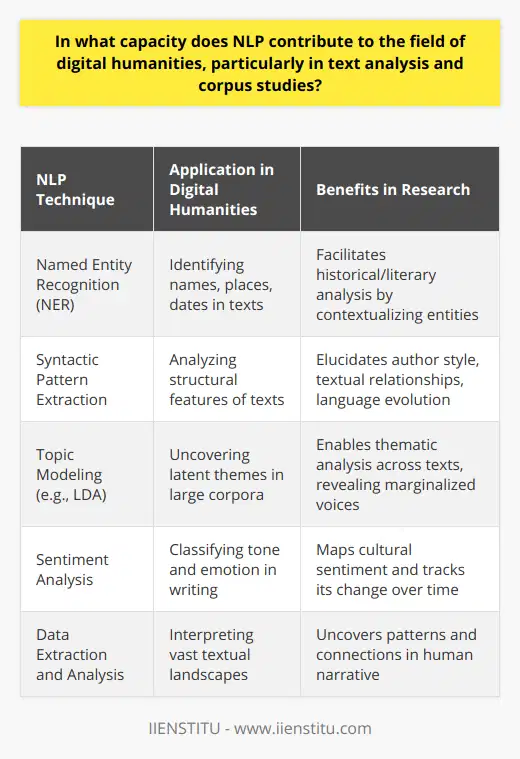
How does NLP aid in the extraction and summarization of essential information from complex academic texts?
**Role of NLP in Text Extraction**
Natural Language Processing (NLP) has proven to be a valuable tool in extracting and summarizing crucial information from complex academic texts. By leveraging advanced algorithms, NLP allows computers to analyze and understand human languages, enabling them to efficiently process and interpret vast amounts of text data.
**NLP Techniques for Text Summarization**
One primary NLP technique utilized for summarizing intricate academic texts is Named Entity Recognition (NER). NER identifies and classifies essential elements, such as people, organizations, and locations within the text, subsequently extracting the most significant information. This vital information can then be utilized for concise summarization, aiding in the understanding of complex ideas.
**Keyword Extraction for Improved Readability**
Another crucial NLP method aiding in summarizing complex content is keyword extraction. This technique identifies critical phrases and terms within the academic text that best represent its central concepts. By focusing on these keywords, researchers and students alike can attain a simplified and accessible understanding of dense material without delving into its intricate details and terminologies.
**Semantic Analysis for Safer Interpretation**
Semantic analysis, applied within NLP, ensures the accurate interpretation and summarization of information by examining the relationships between words, phrases, and sentences in academic texts. This method helps derive meaning from context, reducing the likelihood of misinterpreting or overlooking critical nuances. As a result, NLP-generated summaries are not just concise but also reliable in maintaining the intended essence of complex academic arguments.
**Effectiveness of NLP-driven Summaries**
NLP-driven summaries have proven highly effective in distilling essential information while preserving the core ideas and arguments presented in complex academic texts. They assist scholars and students by rendering frequently challenging and intricate material more accessible, facilitating a broader understanding of the subject matter. Consequently, NLP practices continue to play a key role in the textual analysis and summarization process within academic fields.
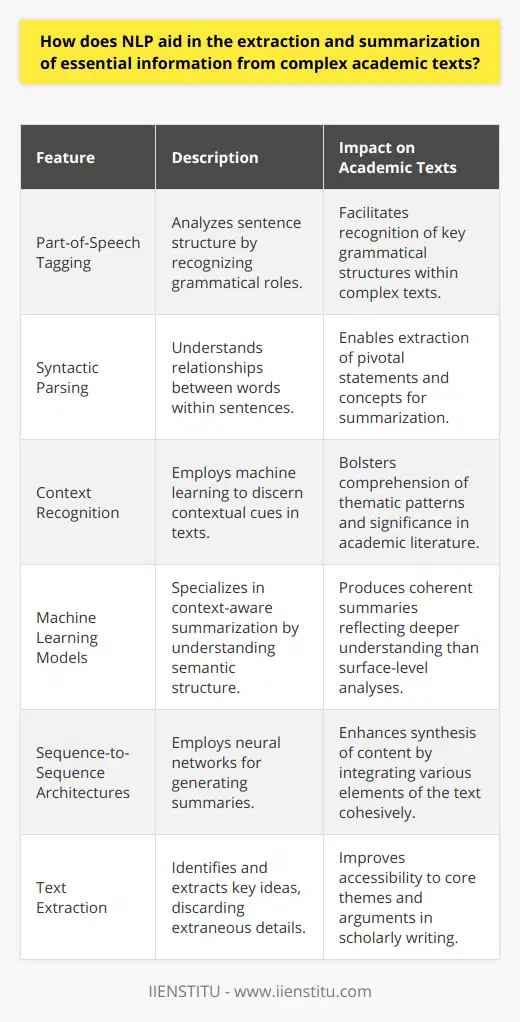
What are the underlying mechanisms within NLP that enable automated summarization of written text?
The Underlying Mechanisms of NLP
The field of natural language processing (NLP) has seen remarkable advancements in recent years, particularly regarding automated summarization of written text. This process requires complex systems that can analyze and simplify a vast array of data. The following mechanisms are essential in achieving automated text summarization.
Semantic Analysis and Representation
The first step in processing text is understanding and representing its meaning. NLP models employ semantic analysis to identify the core ideas, themes, and relationships between data points. This is crucial for filtering out redundant or unnecessary information and retaining only valuable content.
Methods: Extractive vs. Abstractive Approaches
Two primary methods exist for automated summarization: extractive and abstractive techniques. Extractive summarization identifies the most important sections or sentences of a text and arranges them into a coherent summary. In contrast, abstractive methods involve generating new, concise sentences that convey the main ideas in a more condensed form.
Neural Networks and Machine Learning
Machine learning algorithms and advanced neural networks play a significant role in refining NLP techniques. These models can adapt, learn, and improve through training on large datasets, enabling them to better recognize significant concepts and generate meaningful summaries. Neural networks, specifically recurrent models and transformers, have propelled NLP advancements and contributed to the success of advanced text summarization systems like BERT and GPT-3.
Topic Modeling and Clustering
An important aspect of summarization is identifying overarching topics and themes within a body of text. Topic modeling and clustering algorithms analyze keywords, semantic relationships, and patterns to create groups of related information. This enables summarization systems to focus on key points and omit irrelevant details, thereby producing concise and informative summaries.
Conclusion
Automated summarization of written text relies on a combination of semantic analysis, methodical approaches like extractive and abstractive techniques, neural networks, and machine learning algorithms. The integration of these underlying mechanisms enables NLP systems to analyze, synthesize, and generate concise, accurate summaries of complex information with increasing efficiency.
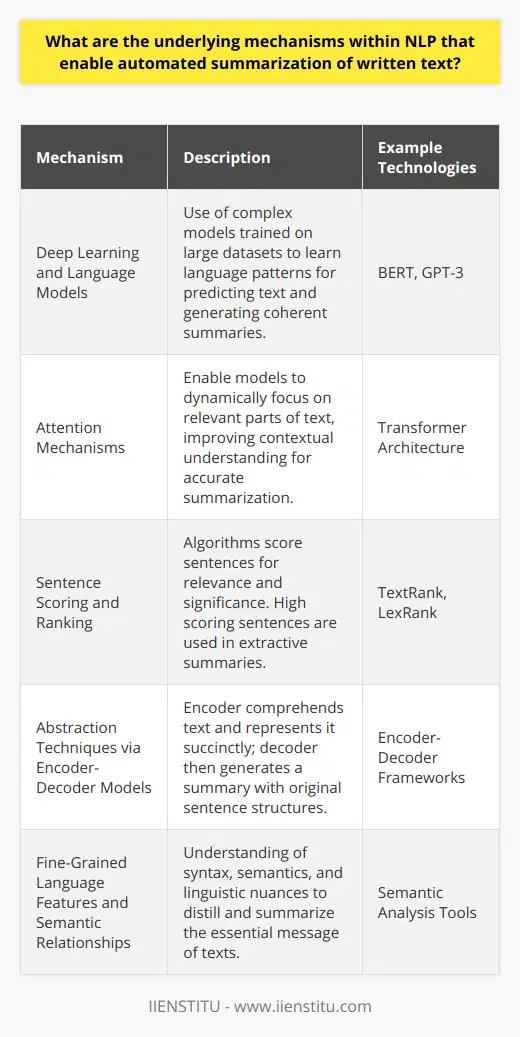
How does NLP assist in the identification and classification of various emotions within text for applications such as sentiment analysis?
**NLP and Emotion Identification**
Natural Language Processing (NLP) assists in identifying and classifying emotions within text by employing computational techniques to analyze, understand, and generate human language. Key components of NLP, such as syntax analysis, semantics analysis, and pragmatics analysis, contribute to the understanding of emotional information conveyed through written language. These techniques enable NLP to extract valuable sentiment information from text data in applications like sentiment analysis.
**Techniques for Classifying Emotions**
To classify various emotions in text, NLP uses several linguistic tools. One effective technique is sentiment lexicon, a collection of words, phrases, and expressions with pre-assigned sentiment values. By assessing the sentiment value of individual words, NLP can estimate the overall emotion present in the text.
Another technique involves machine learning algorithms that leverage patterns and structures in textual data to uncover underlying emotional content. These algorithms, including support vector machines, deep learning, and decision trees, can efficiently classify text data into different sentiment categories based on learned patterns.
**Applications in Sentiment Analysis**
Sentiment analysis refers to the process of determining and categorizing opinions and emotions expressed in text data into positive, negative, or neutral classes. NLP plays a critical role in facilitating efficient sentiment analysis by extracting, analyzing, and synthesizing emotional content.
For instance, in product reviews, NLP can help businesses identify customers' satisfaction or dissatisfaction with their products or services. This enables companies to make data-driven decisions to improve their offerings and enhance customer satisfaction.
In social media analysis, NLP aids in tracking public sentiment toward products, services, and brands, allowing organizations to assess overall brand perception and adjust their marketing strategies accordingly. Additionally, sentiment analysis can be used to monitor public opinion on political issues, providing valuable insights for policymakers and campaign strategists.
**Conclusion**
In summary, NLP is instrumental in the identification and classification of emotions within text for applications like sentiment analysis. By utilizing computational techniques and machine learning algorithms, NLP aids in the extraction and analysis of sentiment information, providing valuable insights for businesses, policymakers, and researchers. As advances in NLP continue, its capabilities in understanding emotional content in text data are expected to grow, offering even more accurate and sophisticated sentiment analysis tools.
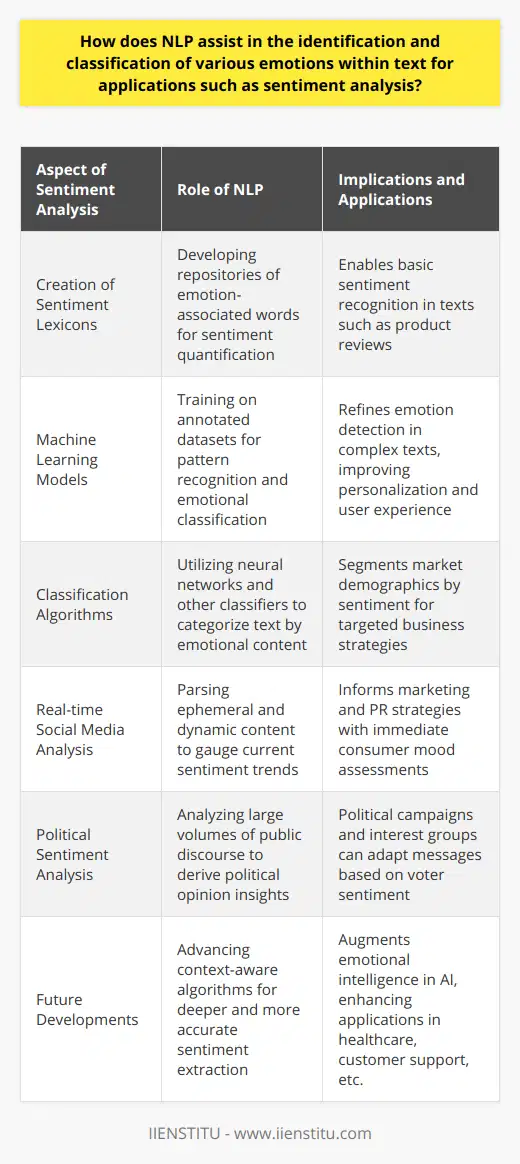
In which ways do NLP techniques contribute to the enhancement of speech recognition systems and natural language understanding in virtual assistants?
Significance of NLP Techniques
Natural language processing (NLP) techniques greatly improve speech recognition systems and natural language understanding in virtual assistants. These techniques contribute to the enhancement of these systems by addressing various challenges in communication.
Enhancement of Speech Recognition
NLP techniques enhance speech recognition systems by accurately transcribing human speech into text, making it much easier for virtual assistants to understand and process users' inquiries. This helps in reducing transcription errors and provides a smoother user experience.
Improvement of Syntax and Grammar Understanding
By employing linguistic rules and algorithms, NLP techniques aid virtual assistants in understanding the syntax and grammar of user inputs. This allows for the correct interpretation of complex sentences and idiomatic expressions, enabling more accurate and efficient responses.
Coping with Ambiguity
NLP techniques foster better understanding of ambiguous user inputs by automatically disambiguating words and phrases, considering factors like context, user history, and local information. This capability helps virtual assistants in providing relevant answers and executing appropriate actions in response to user inquiries.
Semantic Analysis Enhancement
By using NLP techniques, virtual assistants comprehensively analyze the meaning of user inputs through semantic analysis. This involves identifying the relationships between words and phrases, and understanding their overall meaning and intent. Consequently, virtual assistants can respond with precise information, suggestions, or actions.
Handling Multilingualism
NLP techniques enable virtual assistants to support various languages, allowing them to be more accessible and user-friendly. By incorporating language models and translation capabilities, virtual assistants can effectively understand and communicate with users in their preferred languages.
Personalization and Adaptation
Through continuous learning and pattern recognition, NLP techniques allow virtual assistants to adapt to individual users' preferences and requirements. By analyzing users' interaction history, virtual assistants can tailor their responses, anticipating users' needs and providing personalized experiences.
In conclusion, NLP techniques significantly contribute to the enhancement of speech recognition systems and natural language understanding in virtual assistants. By addressing communication challenges such as accurate transcription, syntax and grammar understanding, ambiguity resolution, semantic analysis, multilingual support, and personalization, these techniques ensure a seamless and valuable user experience.
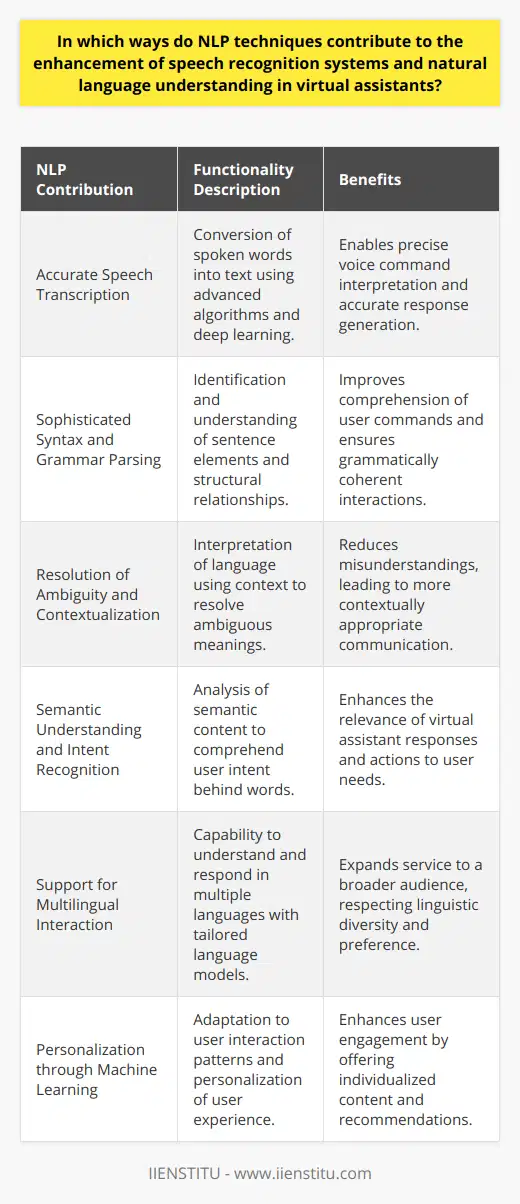
What can NLP be used for in facilitating the understanding and analysis of literary works within the realm of digital humanities?
Enhanced Textual Analysis Through NLP
One significant use of Natural Language Processing (NLP) in digital humanities is enhancing textual analysis of literary works. NLP aids in understanding complex language structures, patterns, and themes within texts. It achieves this by analysing written language computationally, enabling researchers to delve deeper into prominent themes within the literature.
Facilitation of Sentiment Analysis
Furthermore, NLP considerably facilitates sentiment analysis in literary works. It effectively determines subjective information, including writer’s feelings or attitudes towards their textual representation. This assists cultural investigators in gaining insights into the author's emotional intent.
Semantic Analysis and NLP
Moreover, NLP also contributes immensely to semantic analysis within digital humanities. By connecting words and their contextual meanings, NLP efficiently unravels subtle nuances and underlying connotations of literary creations. This, in turn, enriches readers' comprehension and enhances their analytical ability.
Digitization and Accessibility
The shift of literary works to digital formats has increased accessibility. NLP allows for the creation of interactive experiences for end-users, such as digital books that can respond to reader’s queries about the narrative or context. Therefore, NLP is also a tool for democratizing access to literature, contributing toward a more inclusive digital humanities landscape.
Character Network Analysis
Finally, the implementation of NLP in character network analysis provides a systematic study of characters' connections within a storyline. This evaluation helps determine overall narrative structure and contributes to a better understanding and expanded appreciation of literary works.
In conclusion, NLP serves as a conduit between literary works and their readers, aiding in the transformation of literary analysis within the digital humanities realm. Its potential applications are expansive and prolific, encouraging engaging and diverse ways of literary understanding.
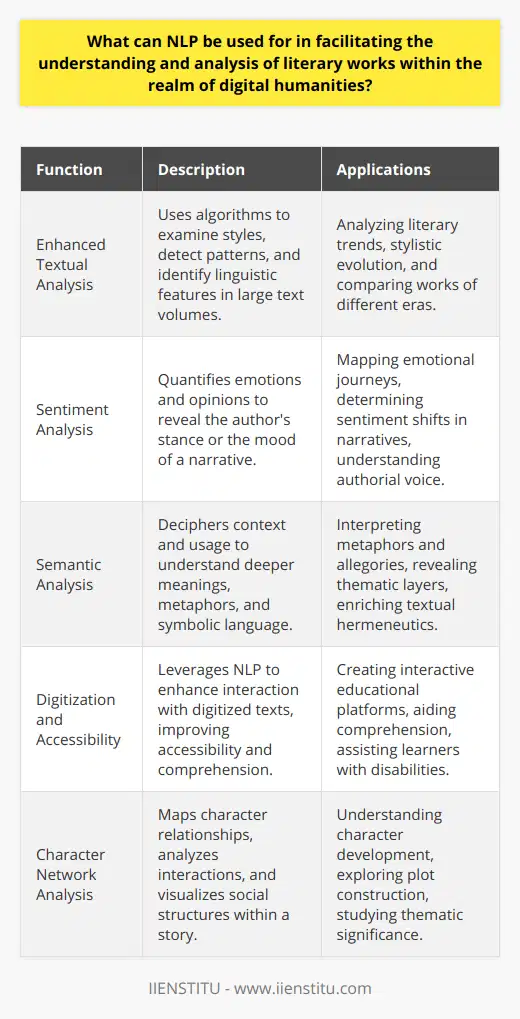
How do NLP techniques assist in the identification and resolution of ambiguities in natural language processing, particularly with respect to homonyms, homophones, and polysemy?
Identifying Linguistic Ambiguities
Natural Language Processing (NLP) uses specific techniques to identify and resolve linguistic ambiguities. One key approach is disambiguation, which discerns the context of words in a sentence. Through disambiguation, NLP can differentiate between the meanings of homonyms and homophones, both of which can present challenges to language understanding due to their similar form but different meanings.
Resolving Homonyms and Homophones
NLP uses algorithms to distinguish between homonyms and homophones, which significantly improve their clarity in communication. These algorithms factor in the context in which the words appear. For instance, they consider the surrounding words in a sentence to clarify its meaning, since words can carry different meanings based on context. They also refer to large databases or corpora of language data to understand the most common usage of a word or phrase.
Polysemy Management
Simultaneously, NLP has developed techniques to address polysemy, a situation where a single word or phrase has multiple meanings. NLP recognises and analyzes the various semantic relationships between words, utilizing semantic networks. The application of these networks helps in distinguishing between numerous potential meanings, depending on context.
Using Word Sense Disambiguation
Word Sense Disambiguation (WSD) is another technique that NLP employs. WSD is a process where the system identifies the meaning of a word based on the context. It uses machine learning algorithms to predict the accurate interpretation of a word, helping in resolving ambiguities.
In summary, NLP techniques play a vital role in identifying and resolving ambiguities in language, particularly relating to homonyms, homophones, and polysemy. By leveraging algorithms, semantic networks, and word sense disambiguation, NLP creates a more precise and effective communication system.
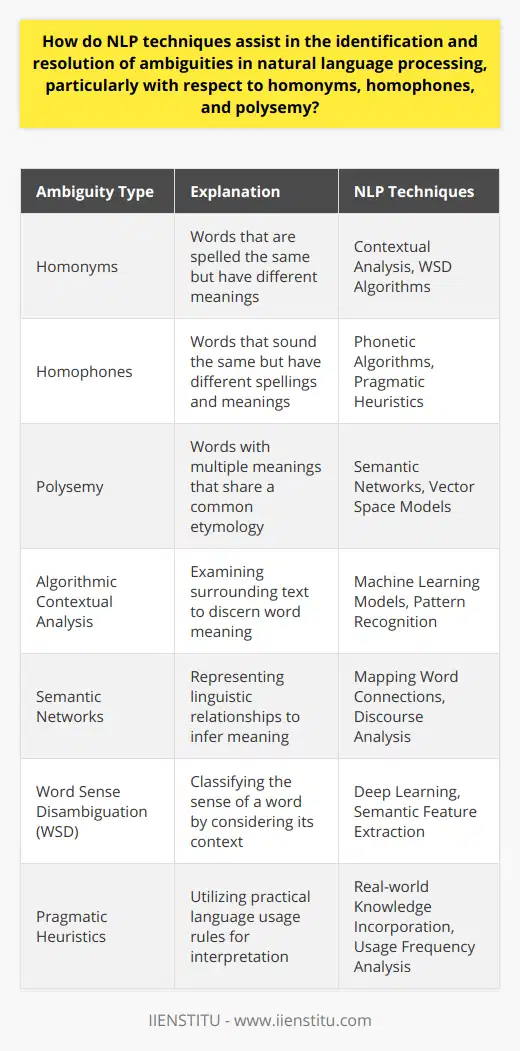
In what ways has NLP contributed to the development and improvement of automated systems for the detection, extraction, and prevention of online hate speech and disinformation?
NLP and Hate Speech Detection
Natural Language Processing (NLP) significantly bolsters the development of automated systems for detecting online hate speech. NLP firms process and interpret human language, allowing systems to evaluate text and detect offensive content.
NLP Advancements in Text Extraction
Moreover, NLP-enhanced technologies help in the extraction aspect. They closely scrutinize online conversations to 'filter out' harmful language. They achieve this functionality using machine learning algorithms trained to recognize hate speech patterns, thereby creating a safer digital environment.
Preventing Disinformation with NLP
Preventing disinformation is another critical area where NLP makes a significant contribution. Advanced NLP techniques identify false news, inaccuracy, or intentional lies, adding a layer of trust and credibility to online discourse. By analyzing content semantics, NLP technologies can consistently identify and flag potential disinformation.
Machine Learning Integration
Furthermore, the integration of machine learning with NLP in these systems has further strengthened the detection and prevention capabilities. These hybrid models learn from existing data, making the recognition of offensive or false content more accurate over time.
NLP's Impact on Future Technologies
In conclusion, NLP has a substantial impact on enhancing the capabilities of automated online hate speech and misinformation detection systems. As NLP technology continues to evolve, its ability to address the growing concern of online harassment and disinformation will likely improve.
